30 Reasons To Make Your Own Sauerkraut and Include a Daily Forkful In Your Diet (and a basic recipe from my book to make your own at home).
This Article Explores The Many Health Benefits of Sauerkraut and includes a full recipe from my recently published book.
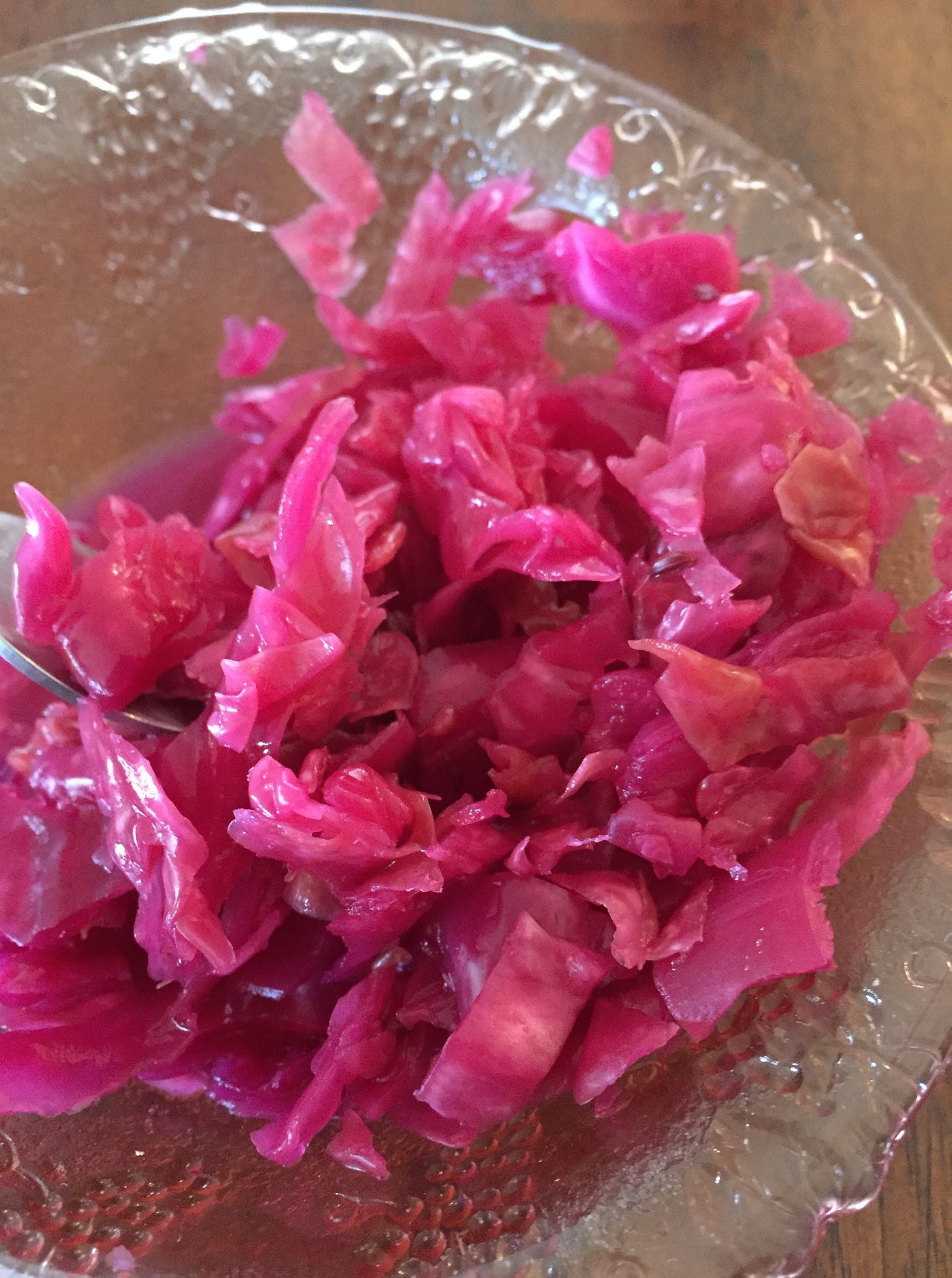
Preserved cabbage looks simple (and the process to make raw cabbage into sauerkraut is indeed quite simple) but the health benefits it offers are off the charts. Raw wild fermented sauerkraut is packed with antioxidants, enzymes, probiotic bacteria and a diverse range of vitamins and minerals.
Cabbages are cheap if you do not grow them yourself and via the simple act of turning cabbage into sauerkraut you unlock a very long list of health benefits and flavor!
The vitamins found in sauerkraut are numerous: Vitamin A, B vitamins, Vitamin C, Vitamin K and Vitamin U. The minerals are iron, potassium, iodine, calcium, magnesium, manganese and sodium along with trace amounts of phosphorus, cobalt, silicon, boron, copper, zinc, sulfur and selenium.
One of the main reason many of us consume sauerkraut is for the live and active probiotics. Probiotics are the bacteria present on the vegetables fermented and grown during fermentation. These various strains of probiotics help make foods more digestible and increase your gut’s ability to absorb nutrients. Lactobacillus plantarum and Lactobacillus acidophilus are a couple of the well known strains that are found in sauerkraut.
Lactobacillus plantarum is extremely hardy and survives the acidic conditions of the stomach as it makes its way to your colon to colonize your gut. Lactobacillus plantarum is known for its ability to produce hydrogen peroxide which your body uses as a defense against pathogenic bacteria as well as bacteria consumed in foods. It is the dominant species of bacteria in sauerkraut.
Lactobacillus acidophilus colonizes most densely in the small intestine where it helps maintain the integrity of the intestinal wall, ensure proper nutrient absorption and support healthy overall digestive function.
Other Species of Bacteria in Sauerkraut
As we continue to improve molecular identification techniques, we have discovered many more species of bacteria in sauerkraut than just the four first identified: Leuconostoc mesenteroides, Lactobacillus plantarum, Pediococcus pentosaceus and Lactobacillus brevis.
Probiotics are measured in colony–forming units or “CFUS.” The bacteria are identified by genus and species. The genus is the first word in a bacterium’s name; it’s the large group to which the bacteria belong. The species is the type of individual bacteria.
Third-party lab testing confirm that anywhere from 80 Billion to 200 Billion CFS are present in a serving of homemade sauerkraut. The bacteria count is maintained at relatively the same level if the product is kept cold.
In essence that means that One Tablespoon of Sauerkraut Equals One Bottle of Probiotics pills in the count of probiotic organisms present. However, in addition to greater numbers of probiotic organisms, that one tablespoon of sauerkraut you made at home also has a wider diversity of probiotic strains than lab cultivated and packaged probiotic pills.
This list of currently known probiotics in sauerkraut includes the original species identified, additional species identified in a 2007 study along with other species currently indicated on various product labels for sauerkraut:
We now know there are a wide range of species of beneficial "probiotic" bacteria present in a wild fermented raw sauerkraut including but not limited to:
Lactobacillus acidophilus
Lactobacillus brevis¹
Lactobacillus coryniformis
Lactobacillus curvatus²
Lactobacillus delbrueckii
Lactobacillus hammesii
Lactobacillus paracasei
Lactobacillus paraplantarum
Lactobacillus plantarum¹
Lactobacillus rhamnosus
Lactobacillus reuteri
Lactobacillus sakei²
Lactobacillus salivarius
Lactococcus lactis²
Leuconostoc argentinum²
Leuconostoc citreum²
Leuconostoc fallax²
Leuconostoc mesenteroides¹
Pediococcus acidilactici
Pediococcus cerevisiae
Pediococcus pentosaceus¹
Weissella koreensis
Weissella species
Your gut wall houses 70 percent of the cells that make up your immune system. Therefore maintaining a healthy gut flora (through eating fermented foods) is of paramount importance for keeping your immune system in good shape.
Don't pay huge money for probiotic pills (that often contain a lower concentration of probiotics and less diversity of species than raw fermented foods) when you can produce your own with a few dollars worth of cabbage, a couple jars and some elbow grease. Homemade sauerkraut is nothing like that store bought pasteurized junk, its crisp, flavorful and tangy.
There is a great peace of mind that comes with getting into the rhythm of preserving seasonal abundances by teaming up with native microorganisms. Learning low tech ancient preservation techniques like lacto-fermentation means that given you have some basic tools and salt you can preserve what ever food is available in the garden (or in the forest) in an emergency situation if need be. It is a practice that also adds joy and fun to one's life in the best of times, brightening up meals with the depth of flavor that fermentation unlocks in various foods.
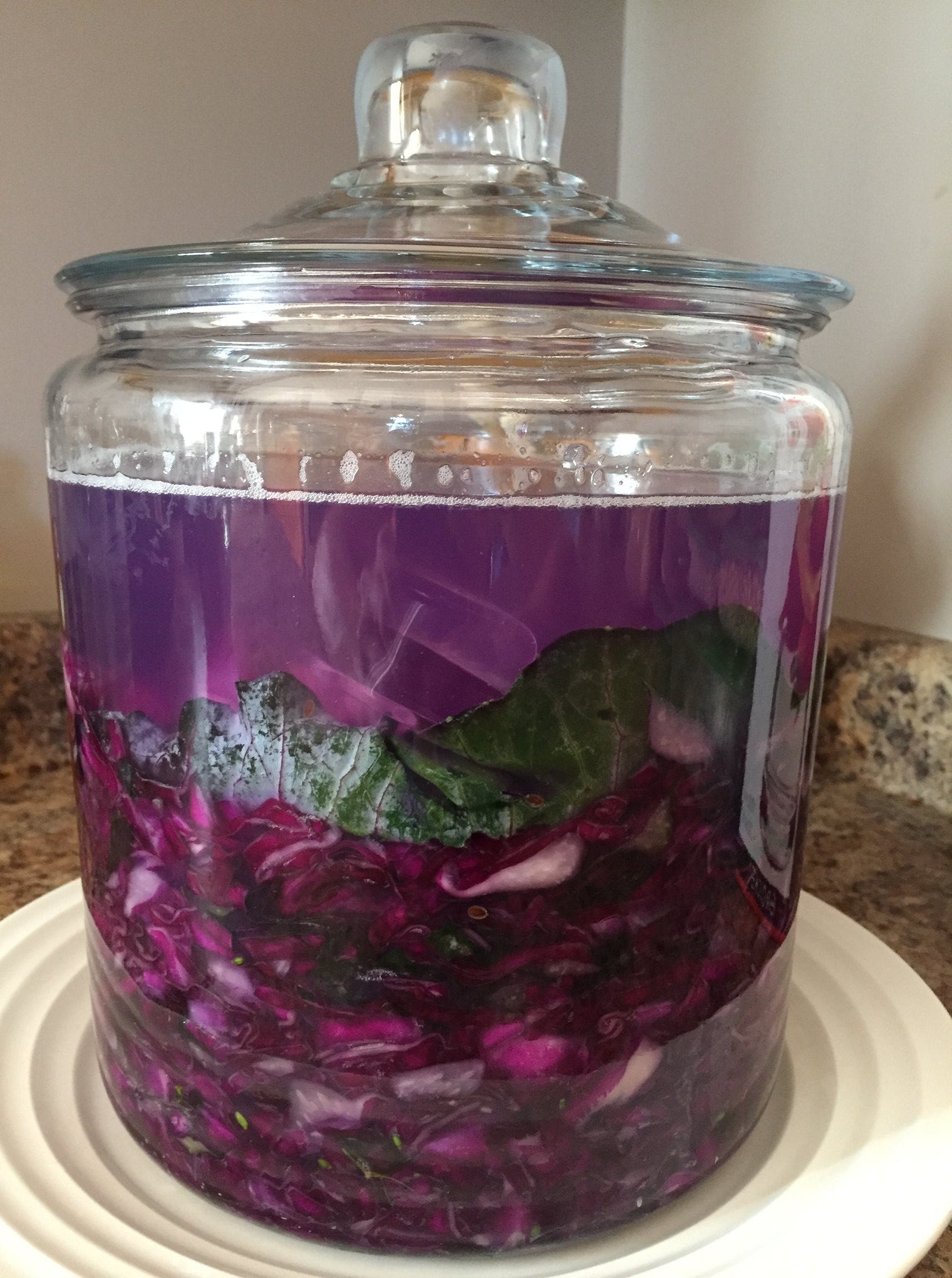
Sauerkraut was one of the gateways to discovering my love for fermented foods (leading my wife to loving them too): Until about 9 years ago, when I heard someone mention the word sauerkraut, I thought “oh, that weird mushy stinky stuff sometimes served with sausages, no thanks”. That all changed 9 summers ago, when I (at the time begrudgingly) decided to make a batch of sauerkraut when we had an abundance of garden cabbages (after having already using them to make massive amounts of borscht). I had read about the long list of health benefits of raw sauerkraut but was nervous about how it would taste. I was blown away when after fermenting our (shredded, salted and pressed down) cabbage in mason jars for 12 days I had my first bite of homemade raw 'kraut', it was soo tasty! Unlike the store-bought stuff it is crisp (not soft and soggy) and the sharp zing and rich flavor of the probiotic-rich brine was to die for! We were both addicted after our first bite. We have made hundreds of batches since then (experimenting with new flavorings and vegetable pairings as we go). Some of my favorites include turmeric and goji berry-infused kraut, harissa-infused kraut and purple kraut with beets. Well, that was my long-winded way of saying, “If you think sauerkraut is gross or meh, don’t dismiss it until you make your own and try the real thing”. Happy cabbage crushing everyone!
my full recipe for Basic Sauerkraut (from my book)
Ingredients:
- 1 medium-sized green cabbage, preferably organic because pesticide and fungicide residue kills the beneficial bacteria you will need to preserve/ferment the cabbage (red cabbage works too, just colors brine a beautiful purple/pink color)
- 2 to 4 tsp. sea salt (2-3 tsps. of salt if you are fermenting at a temperature of 16C-27 Celsius+ (60-80 F) or 3-4 tsps. of salt if your fermenting space will be 27 Celsius+ (80F+).
-(optional) 1 cup water (with 1 ½ tsp salt dissolved into it) for if you need extra brine to fully submerge the ingredients and fermentation weights after adding to the fermenting vessel
- (optional) spices and/or herbs for flavoring (such as dill/”caraway” seed, anise, juniper berries etc)
(Optional Ingredients for Variations)
- 1 apple or 1 beet, grated
- 1 carrot, grated
- fresh ginger root, grated
- a handful or two of kale
sliced into ribbons
- a handful of black berries
- other fun ingredients could include seasonal foraged greens from the forest and/or medicinal herbs and flowers.
Required Tools:
- Large wooden, ceramic bowl (preferably not metal as salt corrodes and can impart metallic taste) or other wide container that is tough enough to withstand "a beating". Some avid sauerkraut makers like to chop an old wine barrel in half and use it to make huge batches that last all year.
- An object for bruising the sliced cabbage such as a rolling pin, pestle or other blunt solid food-safe object
- A sharp knife
- A container that has been washed with hot soapy water and rinsed well (we typically use wide mouth mason jars and/or traditional ceramic fermentation crocks) for fermenting which is large enough to fit a hand into so compression can take place to exclude oxygen by pushing the cabbage down with fist/fingers.
- An object which is to put inside your fermenting container(s) and sit on top of the shredded and bruised cabbage ( weighing it down and keeping the cabbage submerged in its own juices and/or the saltwater brine.) In the past, we have used scrubbed and cleaned off pure flat quartz crystal stones for small jars, cabbage core pieces, and/or glass coasters, shot glasses or smaller jar filled with water for bigger containers. There are also a range of companies that sell glass fermentation weights that are designed to be ideal for this purpose (some of those are shown in the image below).
- (For a those who cannot “burp” (release CO-2 via loosening jar lid for a second) their jars daily and those who do not have a traditional fermentation crock. You will need something breathable to put over your fermenting container such as a tea towel, paper towel which lets out CO-2 (produced during fermenting) but doesn't let in critters).
Instructions:
Begin by removing any wilted or damaged leaves and washing off any dirt. Next, carefully remove an entire leaf and break into a couple of pieces that will be big enough to cover the top of your fermenting container. It will serve as an "organic lid" to keep the shredded cabbage submerged in brine under the weighted object on top.

Next slice the cabbage in half. Then slice in half again making 4 wedges. Slice out the tough core from each wedge and set aside with the previously removed large leaves. Put the core sections through a juicer and use the extra cabbage juice to supplement the brine when adding the shredded cabbage to jars for fermenting (If they are not used in this way they can also be eaten as a snack or put in the compost bin). Next slice the cabbage wedges into thin ribbons.

Add the amount of salt you deem appropriate for your batch into a small bowl so you have easy access to grabbing a pinch here and a pinch there (the amount of salt is based on the temperature-relevant info provided in the ingredients list).
Add the ribbons of cabbage to a sturdy container (in 3-4 inch deep layers). Sprinkle some salt on top. Massage the salt into the cabbage with your hands until it begins to glisten and release its juices (and or use a cabbage bruising device, such as the one shown in the pic below).
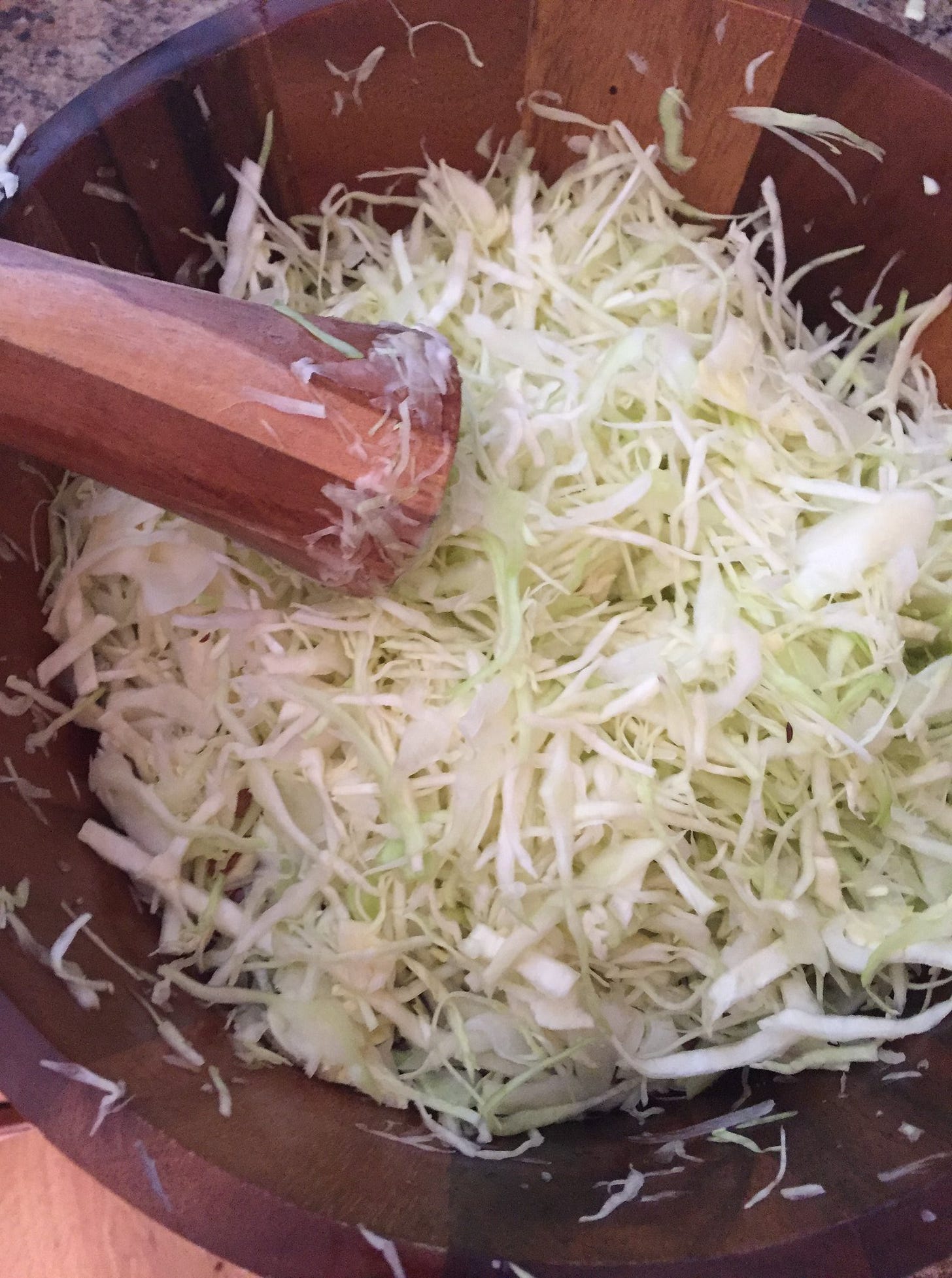
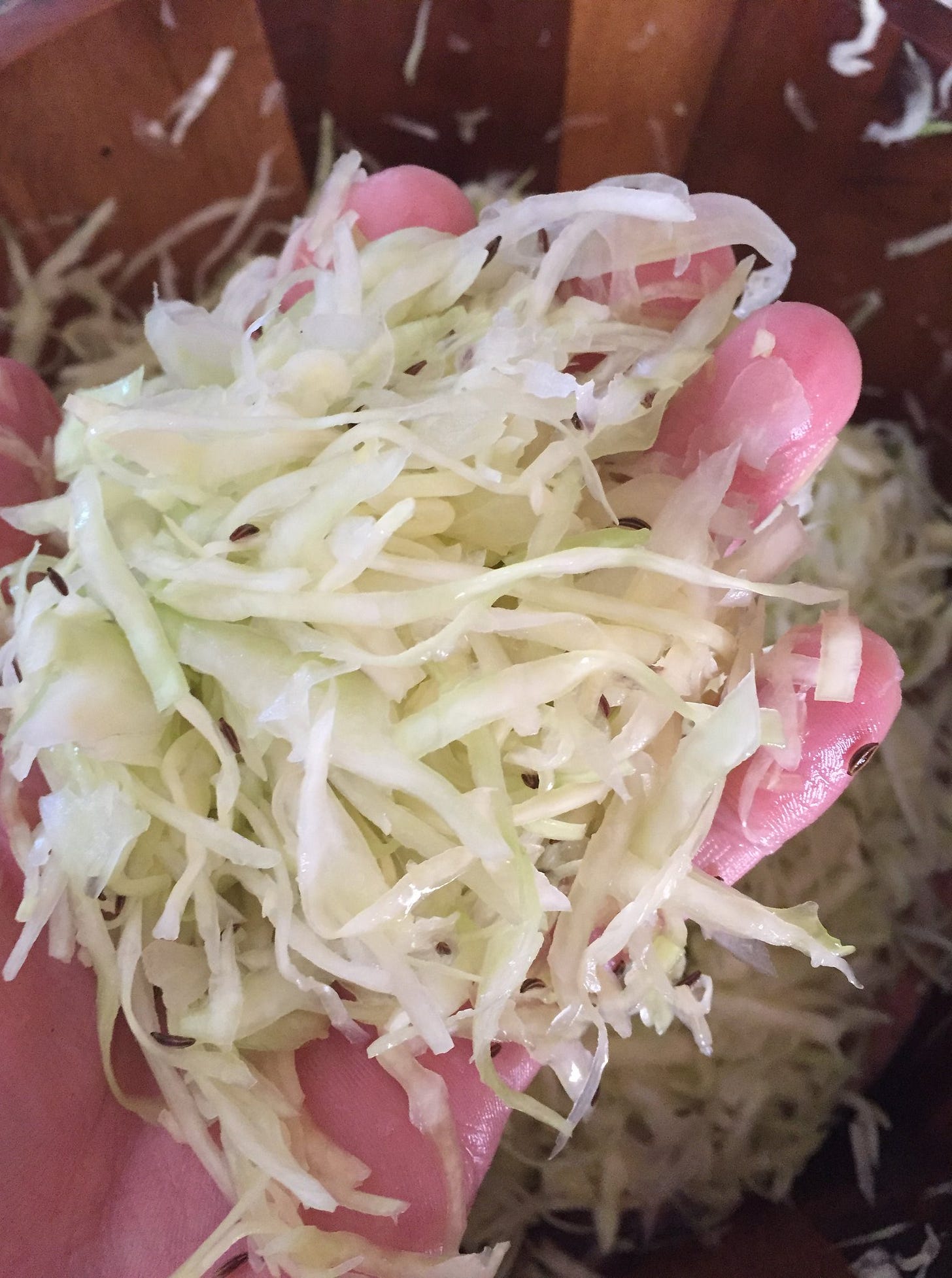
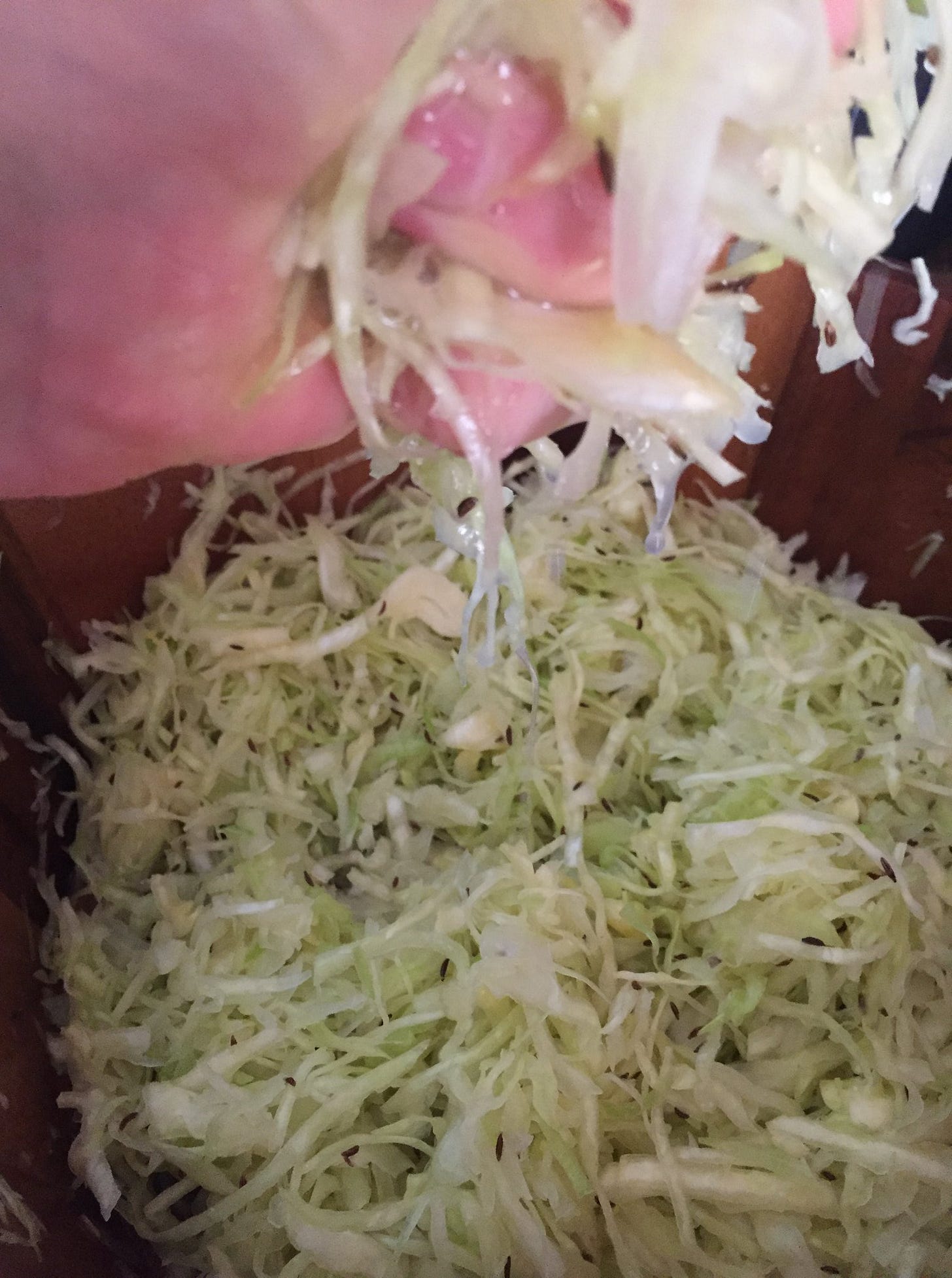
At this point you can either cover the container to keep bugs out and let it sit at room temperature for an hour or so to allow more cabbage juices to be released (potentially giving you more natural brine to work with) or you can just begin the manual bruising process. Begin bruising the cabbage by pounding it and crushing up the rigid bits with the bruising tool (a pestle, rolling pin or another blunt wooden kitchen tool will work fine). Keep working at it for 5-10 min or until you are able to take a handful of bruised cabbage and literally squeeze out the juice.
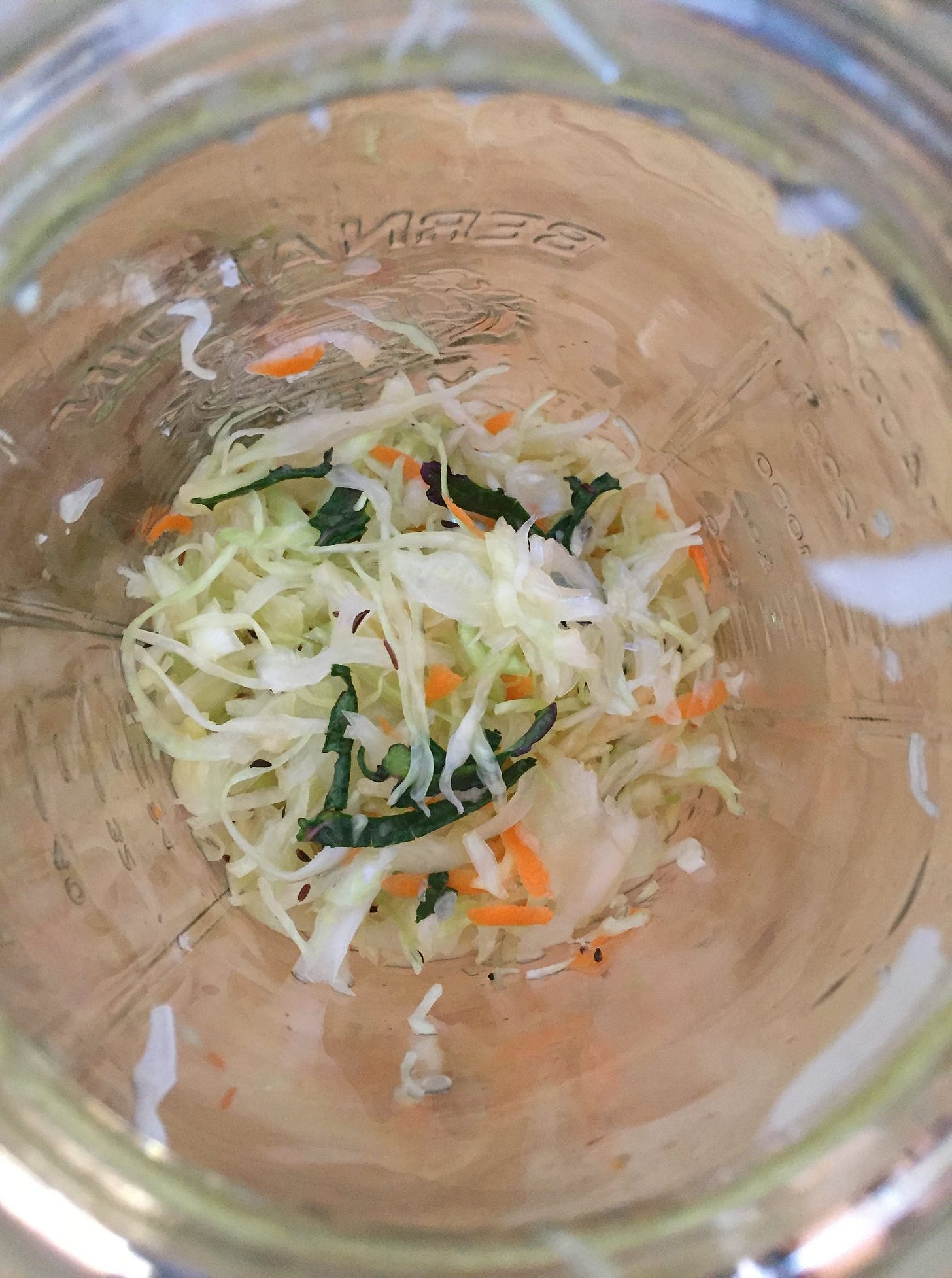
For the final step add the bruised cabbage to jars in layers of about 2-3 inches sprinkling a pinch of salt between each layer. Then press the cabbage down into the bottom of the jar in order to exclude all air bubbles and submerge the bruised cabbage in its own juices, this gets the fermentation process started. Fill the jar only 3/4 full. At this point the brine should appear, if the brine (cabbage juice) is not enough to cover all the bruised cabbage, add a little saltwater brine to make sure the cabbage is submerged in brine at least 1cm deep (to make salt brine dissolve 1 ½ tsp salt into 1 cup (250 ml) of filtered room temperature water by vigorously stirring.
Place your jar (or another fermenting vessel) in a space at room temperature out of direct sunlight. The best way to ensure successful fermentation is to use either an airlock or to seal your container and then check on it daily to release excess pressure (this is called “burping”). With wide mouth mason jars, it is as simple as touching the middle of the lid to see if it is tight (indicating excess CO-2 build-up produced in the fermenting process) and then loosening the lid ring for a second or two until you hear the pressure releasing and then tightening it back up while there is still a bit of pressure inside. By leaving a bit of CO-2 pressure in the jar you ensure an anaerobic environment for your fermenting veggies giving the probiotic microflora exactly what they need to flourish and denying any competing microbes the oxygen they need to survive.
Remember, if you do not have some type of auto release airlock system (such as is provided via a traditional fermentation crock or a specialized mason jar system such as the “Pickle Pipe”) your schedule does not allow for a daily check-up then you will need to cover the top of the fermenting containers with a tea towel or paper towel.*
It is best to check in daily, as you may need to press down the cabbage with clean hands to compact it (as it naturally expands due to CO-2 expulsion during fermentation). Doing this daily ensures the cabbage remains submerged in brine which is important for creating an environment where only the "good" bacteria can survive. The first stage of fermentation (which is required as a minimum to transform your cabbage into sauerkraut) will take approximately 5-7 days, depending on ambient temperature and cabbage foliage lactobacilli counts (but you can let it ferment even longer for a stronger more tangy flavor and encourage an even more diverse and abundant probiotic content).
Begin tasting the sauerkraut daily after the fifth day to find the level of tanginess wanted. Once it is at the desired level, put on a sturdy airtight lid and place it in the fridge. (This slows the fermentation which stabilizes the flavor and texture at the level of when it was placed in the fridge.) Each time you take some kraut out of the jar ensure that the contents are all submerged when you put it back in the fridge (adding extra saltwater brine as required).
If kept submerged in the brine and refrigerated it can keep from 6-12 months. If kept in a root cellar (10-15C) it will keep 4-6 months.

and if you are still not convinced that it is worth making your own sauerkraut at home, here are..
30 Reasons to Make Your Own Sauerkraut and Include a Daily Forkful of Sauerkraut In Your Diet
1. Sauerkraut is the easiest of all the fermented foods to incorporate into your diet.
Once fermented, that jar of sauerkraut sits in your refrigerator ready to eat.
Scrambled eggs for breakfast? Add a forkful of Kimchi Style Sauerkraut, chopped avocado and a dollop of sour cream.
Salad for lunch? Sprinkle some Pink Sauerkraut on your lettuce and top with a few shavings of Parmesan cheese.

Dinner? Place any flavor of sauerkraut as a condiment on your plate and add zing to your meal and aid in its digestion.
Need more inspiration on ways to include it in your diet? See: 7 Easy Ways to Eat Sauerkraut.
2. Sauerkraut will improve your digestion
Sauerkraut will improve your digestions within a few days, especially if you are one of 70 million people who suffer from digestive diseases in the United States alone.
Your digestive system contains 100 trillion microorganisms, a number 10 times greater than all the cells in your body. To say they are important is an understatement.
Indigestion, bloating, headaches, brain fog, skin issues, constipation, weight gain, fatigue, back pain? When the ecosystem of your gut has the proper balance of stomach acids and bacteria, your body is able to properly break down food for nourishment and cell repair. If it is not able to absorb nutrients from the foods you eat and eliminate wastes, all types of health issues may arise.
Fermented foods, of which sauerkraut is one, strengthen the health and balance of your digestive system. Improved digestion, that accompanies a healthier gut, makes for improved health.
3. Eating sauerkraut will help to reseed your gut if you’ve taken a course of antibiotics.
Lab made antibiotics are sometimes helpful in extreme situations (though I prefer to use nature’s antibiotics when ever possible myself).
While these drugs can be helpful in certain situations, unfortunately, if you have taken pharmaceutical antibiotics, they work by destroying bacteria and interfering with the formation of bacteria, both the good and the bad.
Every course of antibiotics tends to wipe out the beneficial bacteria and that gives a window of opportunity for the pathogens to proliferate, to grow uncontrolled, and to occupy new niches in your gut. The beneficial flora recovers, but different species of it take between two weeks to two months to recover in the gut and that’s a window of opportunity for various pathogens to overgrow. Dr. Campbell McBride, interview with Dr. Mercola
Dr. Campbell McBride, interview with Dr. Mercola
Don’t give those pathogenic bacteria a chance to gain hold. Reintroduce good bacteria by eating sauerkraut and other fermented foods.
4. Sauerkraut is the perfect “Gateway Ferment.”
Learning to make sauerkraut is perfect for your first foray into fermentation. Hence, the dubious label, the “gateway drug” of fermentation.
It is simple to make. No fancy jars required. No expensive equipment. Just cabbage, salt and time, which can be as little as 7 days!
So get started with my recipe above. And, if you never move beyond the fermentation of sauerkraut, don’t worry there’s plenty of goodness in sauerkraut.
5. Eating sauerkraut will not only improve your gut bacteria but will improve your brain function.
Did you know that your digestive system actually produces more neurotransmitters than your brain does? And, that the bacteria you ingested in food can affect brain function?
In an early proof-of-concept study, UCLA researchers found that women who regularly consumed probiotics through yogurt showed altered brain function while in a resting state and in response to an emotion-recognition task.
Functional magnetic resonance imaging (fMRI) scans conducted both before and after the four-week study period looked at the women’s brains in a state of rest and in response to an emotion-recognition task in which they viewed a series of pictures of people with angry or frightened faces and matched them to other faces showing the same emotions.
The researchers were surprised to find that the brain effects could be seen in many areas, including those involved in sensory processing and not merely those associated with emotion. Research learned that signals are sent from the intestine to the brain and that they can be modulated by a dietary change.
Many of us have a container of yogurt in our refrigerator that we may eat for enjoyment, for calcium or because we think it might help our health in other ways. Our findings indicate that some of the contents of yogurt may actually change the way our brain responds to the environment. When we consider the implications of this work, the old sayings ‘you are what you eat’ and ‘gut feelings’ take on new meaning.– Dr. Kirsten Tillisch, associate professor of medicine in the digestive diseases division at UCLA’s David Geffen School of Medicine
– Dr. Kirsten Tillisch, associate professor of medicine in the digestive diseases division at UCLA’s David Geffen School of Medicine
The yogurt used in this study was commercial yogurt with notoriously low levels of probiotics. Consuming yogurt you make yourself, kefir or… sauerkraut will have an even greater impact on your gut health.
6. Sauerkraut Contains Compounds That Assist With Glyphosate Detox
The continued use of excessive amounts of highly toxic chemicals that are used in conjunction with GMO farming practices has left the water contaminated, the air contaminated, most store bought non-organic food contaminated and the soil depleted.
We can at least take back control of the impact this dangerous biocide has on our health by eating foods like sauerkraut each day to help mitigate the harms done to our cells and help reverse the damage of that systemic biocide.
7. Sauerkraut is a VERY inexpensive probiotic.
A month’s supply of probiotics can easily set you back $20-$40. The cost for a month’s supply of sauerkraut is a head of cabbage and a few jars. What could be more economical? See Triple-Digit Cost Savings of Your DIY Sauerkraut [9 IMPORTANT BENEFITS]
8. Sauerkraut and other types of fermented cabbage recipes comes in many flavors and can be made in even more flavors, to please any palate.
It is estimated that there are over 100 varieties of Kimchi, a style of sauerkraut popular in Korea. Chonggak Kimchi (Young Radish Kimchi), Oisobagi (Cucumber Kimchi) and Pa Kimchi (Green Onion Kimchi) to name a few.
9. Sauerkraut contains more probiotics than the stuff you buy in a bottle.
Fermented foods not only give you a wider variety of beneficial bacteria, but they also give you far more of them, so it’s truly a much more cost-effective alternative.
Here’s a case in point: It’s unusual to find a probiotic supplement containing more than 10 billion colony-forming units. But when a team for Dr. Mercola actually tested fermented vegetables produced by probiotic starter cultures, they found 10 trillion colony-forming units of bacteria. Literally, one serving (a few forkfuls) of the fermented vegetables was equal to an entire bottle of a high potency probiotic! So clearly, you’re far better off using fermented foods.
Goldmine Natural Foods also had their sauerkraut tested. Independent lab testing showed 7.8 million CFU’s (Colony Forming Units) of live lactobacillus and bifidobacterium species per gram. That’s 468 million per ¼ cup serving!
10. Saurkraut offers radioprotective, radiomitigative and/or radiomodulatory benefits.
Many people feel helpless in the face of the hazards posed by the proliferation (and unpredictable nature) of sources of ionizing radiation and artificial EMFs (given the precarious situations where wars are being started, stoked and expanded by racketeering cartels and the proliferation of 5G tech in urban areas). Nature offers us pathways to protect and heal our bodies in the face of this onslaught of artificial radiation bombarding our cells.
Sulfur-rich vegetables (Sulfur-rich Cruciferous vegetables like broccoli, kale, cabbage, mustard greens, arugula, Bok choy, Brussels sprouts, cauliflower, collards, horseradish, kohlrabi, radishes, turnips, wasabi and watercress) provide us with antioxidants, indoles and sulfur. Supplements can be helpful in creating a nutrient rich environment in which radioactive imposters are crowded out and also combine with and then eliminate heavy metals and helping to prevent free radical damage.
Probiotic rich lacto-fermented foods such as Kimchi, Sauerkraut, Gundruk and Miso (via the action of the beneficial bacteria that protects intestinal epithelium from radiation injury and/or their secreted bacterial products which have unique radioprotective properties.)
11. Making sauerkraut will open your mind and connect you with trillions of your closest – microscopic – friends.

We humans are mostly microbes, over 100 trillion of them. They live and thrive in the mouth, gut, nasal passages, ear canal and on the skin. The bacteria in the microbiome help digest our food, regulate our immune system, protect us against disease and produce vitamins.
I see the act of making sauerkraut (or any fermented food) as a form of 'macro to micro diplomacy'. It involves forging an alliance with organisms more ancient and well equipped than we humans to face invaders on the micro-scale.
I feel this is especially important in these times when it seems as though a large portion of our entire species has decided to declare war on all microscopic life.
Personally I feel it would be more wise to forge (and re-affirm existing) alliances with beneficial microscopic lifeforms (rather than engaging in a futile attempt to kill all microbes). After all, we macroscopic lifeforms are only distant observers of their realm.. our feeble attempts to use synthetic weapons to vanquish our microscopic foes often only makes them stronger. Lactic Acid Bacteria (and other beneficial microorganisms) on the other hand know the enemy (pathogenic organisms such as viruses) well.. they have faced them on the battle field face to face for countless millennia.. they know the terrain and can effectively drive the intruders out.
The truth is we depend on microscopic lifeforms, in fact we (humans) are composed of myriad organisms. Only 10% the cells in our body contain our unique DNA.. our bodies are actually more a community of lifeforms (rather than a single lifeform). Whether it be in the compost heap or in our gut, teaming up with symbiotic microbes is our best chance to stay resilience and adaptable in challenging times.
These microbes are very small, and even though they outnumber human cells by a factor of ten, they only make up 1 to 3 percent of our body mass. That’s 2 to 6 pounds of bacteria in a 200-pound adult. These microbes are generally not harmful to us, in fact, they are essential for maintaining health.
The Human Microbiome Project was funded in 2008 with the mission of characterizing the human microbiome and analyzing its role in human health and disease. Daily, more and more discoveries are being made about how our microbiome impacts our health. Make friends with them, understand their function and do what you can to make sure they are working for you.
When you make a batch of sauerkraut, you are inviting the microbes in the air, on your counter, on your hands, and on that cabbage into the fermentation jar and asking them to eat the sugars in the vegetables, multiply rapidly and make copious amounts of lactic acid for you, so they can preserve the cabbage and create sauerkraut tang!
I feel that in order to be able to thrive and be resilient in the years and decades to come it will be imperative for individuals to forge lasting alliances and symbiotic relationships with our elder species in the fungi and bacteria kingdoms. This (by extension, through the role of bacteriophages and other viruses) applies to the universe of viruses as well. These organisms (and/or particles of genetic information) are an omnipresent facet of nature that we should at the very least have respect for (and perhaps in the case of some species learn to optimize our existing symbiosis with).
In evolutionary biology terms, this is called symbiogenesis, it is a process that we engage with in the garden, in the kitchen and in the forest. It takes a conscious effort and it takes moving away from Germaphobia, Xenophobia and Anthropocentrism and moving instead moving in the direction of way of living that embodies reverence for all life, humility, conscious acts of symbiogenesis and reciprocity.
Engaging symbiotically with the kingdoms of bacteria (through fermenting veggies) invites us to open our minds and to take a step back and look at the bigger picture to see that we can choose to be as a 'probiotic' which is part of Mother Earth's 'macro-biome' or we can behave pathogenically and potentially precipitate her needing to activate her immune system and respond to the threat accordingly.. the choice is ours.
12. Eating sauerkraut can compensate for decreased production of hydrochloric acid as we age.
As we age, our stomach’s natural secretions of hydrochloric acid decrease. Hydrochloric acid acts as a barrier to prevent harmful bacteria and parasites from invading your digestive system. Hydrochloric acid also improves digestion in our stomach by breaking down food so it can be more easily absorbed by the small intestine.
The lactic acid from sauerkraut can partially compensate for reduced hydrochloric acid by introducing beneficial bacteria that can reproduce and turn into more lactic acid.
13. Sauerkraut contains more Vitamin C than the cabbage it was made with (magic happens in that jar or crock of fermenting goodness).
The fermentation process increases the bioavailability of nutrients rendering sauerkraut even more nutritious than the original cabbage. So the Vitamins C, E, and K already present in the cabbage are better utilized by your gut by consuming the fermented cabbage – sauerkraut! – instead of eating coleslaw.
14. Sauerkraut optimizes the function of your innate immune system.
70-80% of our immune system is located in our gut.
If you have poor gut flora and suffer from digestive issues, you’ll be more susceptible to colds and flu.
Just before COVID 19 was declared a "Pandemic" I speculated (based on past trends with so called ‘pandemics’ and epidemics as well as based on my understanding of fermented foods and how they interact with the human body) that one of the main reason places like South Korea had a relatively low mortality rate was due to the fact that many of the people that call that region home regularly eat fermented vegetables. Now that we have more data on this virus (and how it has impacted specific demographics globally) there are new studies that are now confirming this to be the case. Don't take my word for it, check out one of these studies for yourself: https://www.medrxiv.org/con.../10.1101/2020.07.06.20147025v1
"For each grams per day increase in the average national consumption of fermented vegetables, the mortality risk for COVID-19 decreased by 35.4%."
Fermented foods are packed with antioxidants, minerals and a broad spectrum of nutrients that are more bio-available to our body than non-fermented foods. In addition to that, the beneficial bacteria contained in fermented vegetable preserves offer a 'download' of ancient genetic intelligence that essentially informs our cells how to de-activate pathogenic genetic information packets (aka viruses) and harmlessly expel them from the body.
By eating sauerkraut, and other foods rich in probiotics (kefir, yogurt, kimchi), you are improving your gut flora and reducing the chances of catching every bug that flies your way.
15. Sauerkraut is kid-friendly.
When you add a bit of sweetness to your sauerkraut, with either grated carrots or a grated apple, most children enjoy it. In our family, a few jars of sauerkraut sit on the table with the evening meal. We each then choose our flavor and add a few forkfuls to our plate.
If this doesn’t work, try tossing some sauerkraut into a salad or next time you make tacos, add a bit of kimchi to the fixings.
Remember, sauerkraut is teeming with beneficial bacteria and eating just a few strands of the stuff can do wonders.
16. Making sauerkraut will change what you fear in life.
We have been so ingrained to not leave food on the counter for fear that the bad stuff – botulism! – can take hold and rapidly multiply. Don’t worry botulism does not grow in the acidic environment created in the fermentation process for sauerkraut.
The bacteria Clostridium botulinum is everywhere. We don’t get sick from it because most of the time it lies dormant. According to some research by Tim Hall on the Wild Fermentation forum: “C. botulinum prefers an anaerobic (oxygen-free) environment that’s not too acidic, not too salty and not too crowded with other bacteria.”
C. botulinum does not like the bacteria in sauerkraut. In addition, the salt we add in the fermentation process creates an environment hostile to C. botulinum.
So instead of worrying about the food you are making with your own hands in your own kitchen, question your lack of fear for consuming canned and packages foods made in huge factories by no-name people we have no relationship with us.
“The problem with killing 99.9 percent of bacteria is that most of them protect us from the few that can make us sick.
Given the 'War on Bacteria' so culturally prominent in our time, the well-being of our microbial ecology requires regular replenishment and diversification now more than ever.
Wild foods, microbial cultures included, possess a great, unmediated life force, which can help us adapt to shifting conditions and lower our susceptibility to disease. These microorganisms are everywhere, and the techniques for fermenting with them are simple and flexible.
To ferment your own food is to lodge an eloquent protest--of the senses--against the homogenization of flavors and food experiences now rolling like a great, undifferentiated lawn across the globe. It Is also a declaration of independence from an economy that would much prefer we were all passive consumers of its commodities, rather than creators of unique products expressive of ourselves and the places where we live.
Resistance takes place on many planes. Occasionally it can be dramatic and public, but most of the decisions we are faced with are mundane and private. What to eat is a choice that we make several times a day, if we are lucky. The cumulative choices we make about food have profound implications. Food offers us many opportunities to resist the culture of mass marketing and commodification. Though consumer action can take many creative and powerful forms, we do not have to be reduced to the role of consumers selecting from seductive convenience items. We can merge appetite with activism and choose to involve ourselves in food as co-creators.”
― Sandor Ellix Katz (from "The Art of Fermentation")
17. Learning about sauerkraut serves as a gateway to introduce you to cultures from around the world.
If you lived in Korea, every November you would be given a “bonus” and time off to prepare Kimchi, a type of fermented cabbage preserve (like a more advanced spicy sauerkraut) for the upcoming winter. Kimchi is the flaming heart of Korea, a spicy national dish made with Napa cabbages, radishes, green onions, ginger, garlic, and a chili paste.
Giant-sized Napa cabbages are unloaded everywhere. Families gather together soaking the cabbages in a brine, chopping vegetables and making chili paste.
In the Seoul City Hall plaza, over 2,000 volunteers gather to make kimchi for the needy. 270 tons were made one recent year. That is a lot of kimchi.
Kimchi considered one of the secrets to longevity in Koreans: https://www.dailysabah.com/food/2019/06/13/kimchi-the-korean-secret-to-a-long-life (thanks for the link to this article
)And, Koreans consume a lot of kimchi; 1 quart weekly! Americans and Canadians consume approx. 1 quart of sauerkraut annually. Let’s see if we can catch up with them.
I already shared my recipe for a deep purple colored fiery kimchi I like to call “Purple Dragon Chi” recently, and I will also be sharing my recipe for a more basic, culinarily versatile and down to earth Kimchi we like to make with our garden harvests that I like to call “Garden Chi” here on Substack later this month.
18. Making your own sauerkraut will save you money.
As of , the average price for a 16-ounce jar of Pickled Planet sauerkraut was $7.50. You need two of these to make a quart: $15.00. If your family eats a quart per week, you would have spent $780 annually on sauerkraut. Those numbers have obviously drastically gone up since then.
If we buy organic cabbage at $2 per pound, need 2 pounds per quart and throw in some other vegetables and some salt, your costs might be $6 per quart. Making your own would cost $312, annually.
Yes, you do have start-up costs of jars, lids, a scale, and an optional mandoline. Purchase those your first year and then, use your savings to buy a fermentation crock which contains a clever design that allows carbon dioxide to escape the crock while keeping unwelcome microbes like mold out and takes the flavor profile of sauerkraut to a whole new level.
19. Making your own sauerkraut will empower and educate your friends as you share your skills with them.
Let’s say, for instance, that you teach four people how to make sauerkraut, then each of them teaches four more people, who each teach four more people….
The cycle only needs to repeat itself seven times and we’ve packed out Yankee Stadium (meaning over 50,000 jars of sauerkraut have been made!) one-and-a-half times. Repeat it thirteen times and we’ve got more than the entire population of the United States with a jar of sauerkraut on their dinner table. High aspirations, I admit, but why not?
Making sauerkraut will force you to practice the art of patience.
Waiting for up to 28 days before you can eat something is not practiced in our culture of instant gratification.
The watching and waiting are fun for the first week. Aromas fill your kitchen. The microbes are so active, brine overflows the fermentation vessel. Little bubbles rise to the surface. If you are using a crock, you’ll hear little blop, blops as the air escapes the crock. And then, visible action stops, and you wait. And as you wait, the flavor continues to develop.
Inpatient? It’s “legal” to start eating your delicious homemade sauerkraut in just 7 days.
20. Making sauerkraut will awaken your taste buds.
You`ll never know food could taste so good. There is a depth of flavor to fermented foods that is no match to the industrially processed stuff.
Just compare a can of pasteurized sauerkraut to a colorful jar of artisanal sauerkraut found at your local health food store or made by you! Or, freshly brewed Kombucha to a can of soda pop.
There is a deep satisfaction found in eating food that is alive and rich in nutrients.
21. Eating sauerkraut may reduce the incidence of breast cancer.
Researchers fed mice a fast-food diet. Compared to controls, these mice had a predisposition to mammary (breast) cancer. Researchers then repeated these trials but gave some of these fast-food mice the probiotic, Lactobacillus reuteri. Those mice that received the probiotic had a significantly lower rate of mammary cancer symptoms than those that didn’t.
The researchers go on to suggest that L. reuteri may be increasing the development of a certain type of immune cell which may be responsible for exerting the underlying anticancer effects they are observing.
Probiotic bacteria decreased already developed tumors, and, in some cases, prevented tumor growth in animals predisposed to cancer by directly influencing the immune system. These results reinforce the idea that probiotics are important for a healthy immune system, which is important for overall health.
L. reuteri is found in many fermented foods including fermented dairy products, fermented meat products, and lactic acid fermented vegetables, that is sauerkraut. So keep eating that yogurt, kefir, and… sauerkraut!
22. Making sauerkraut will free your creative spirit.
For instance, sometimes when I am chopping, slicing, shredding and bruising up the ingredients while making fermented veggie recipes I just have to stop for a moment and appreciate the rich spectrum of color, texture and invigorating aromas present in front of me.. the process in and of itself is nourishing to the imagination and provides poetry for the senses.
Then comes the process of encouraging the community of beneficial bacteria to proliferate and ensuring they have an ideal environment to thrive and do their important work… that too is a process that offers it’s own form of nourishment for the mind and the soul as it offers opportunities to develop one’s patience, pattern recognition capabilities and humility (through accepting we cannot get the intended end result without the help of our elder species in the L.A.B. kingdom). The finished result is profoundly rewarding (both to the body, mind and soul) but so is the creative process, this is one of the reasons I love fermenting food so much (that along with the immense health benefits offered and the fact it is a method of preserving seasonal abundances that can be engaged in with low tech tools in off grid situations).
Here are a few pics of a couple the fun and wacky ingredients and variations of sauerkraut I have made over the years.
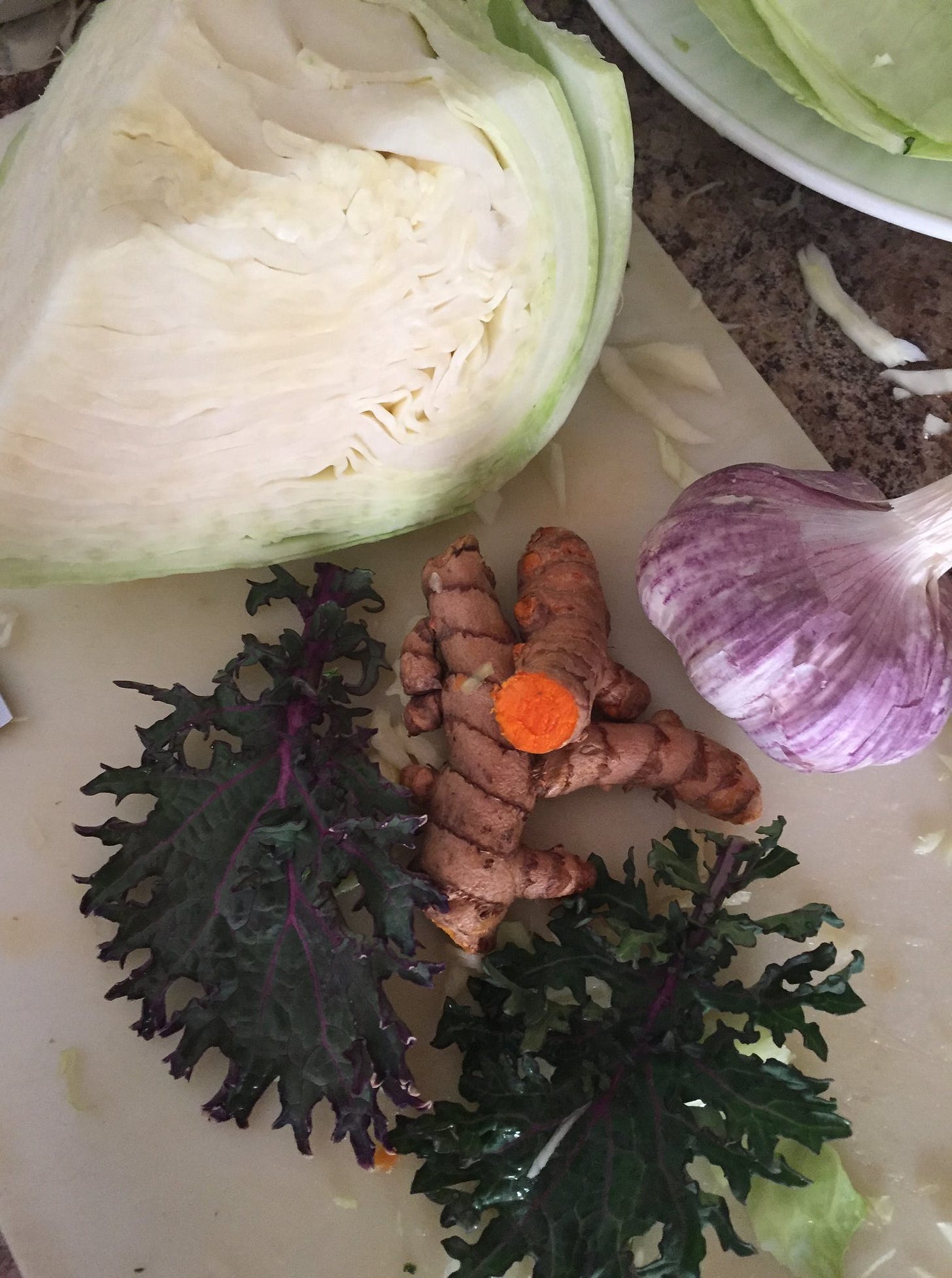

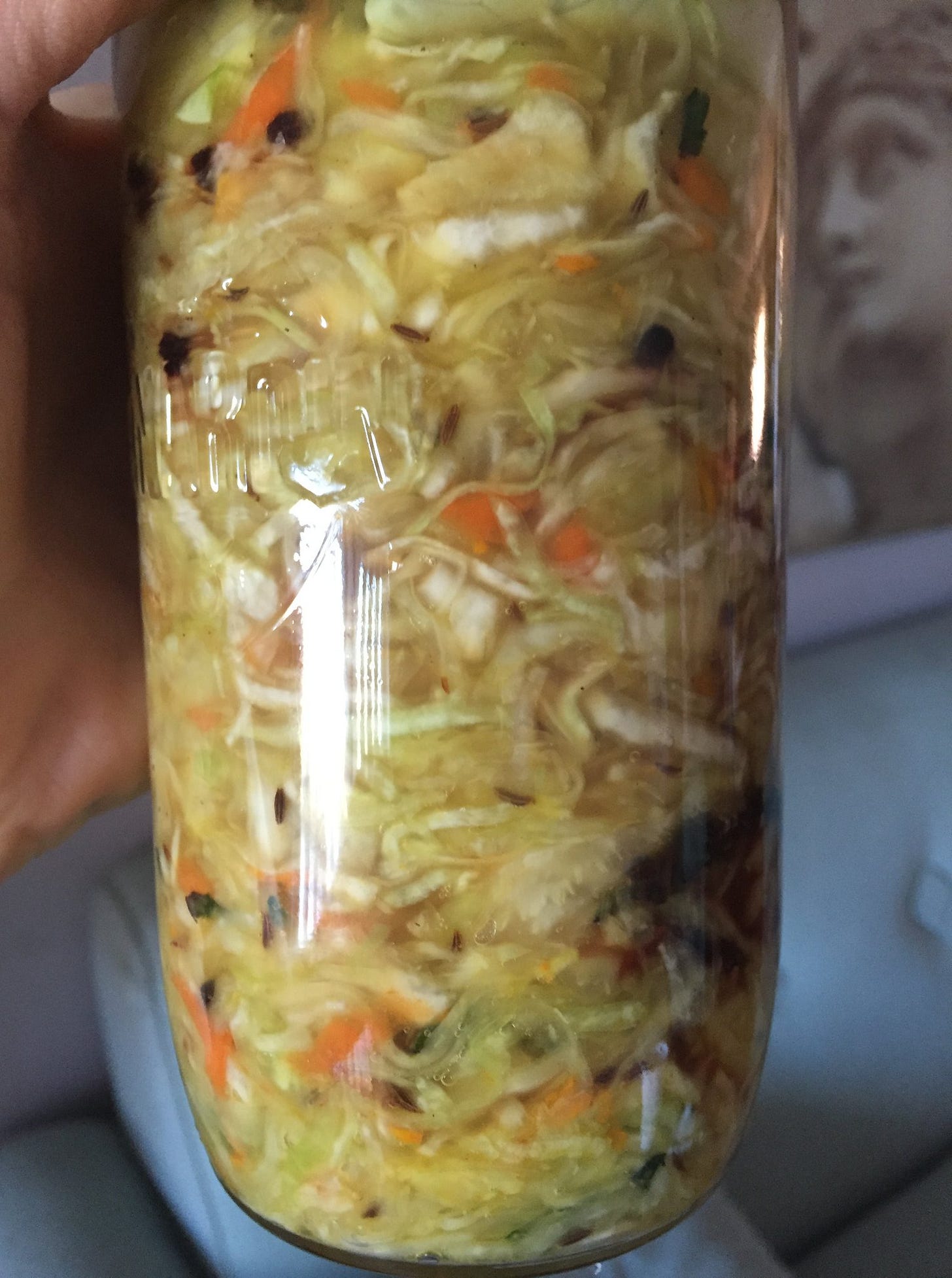


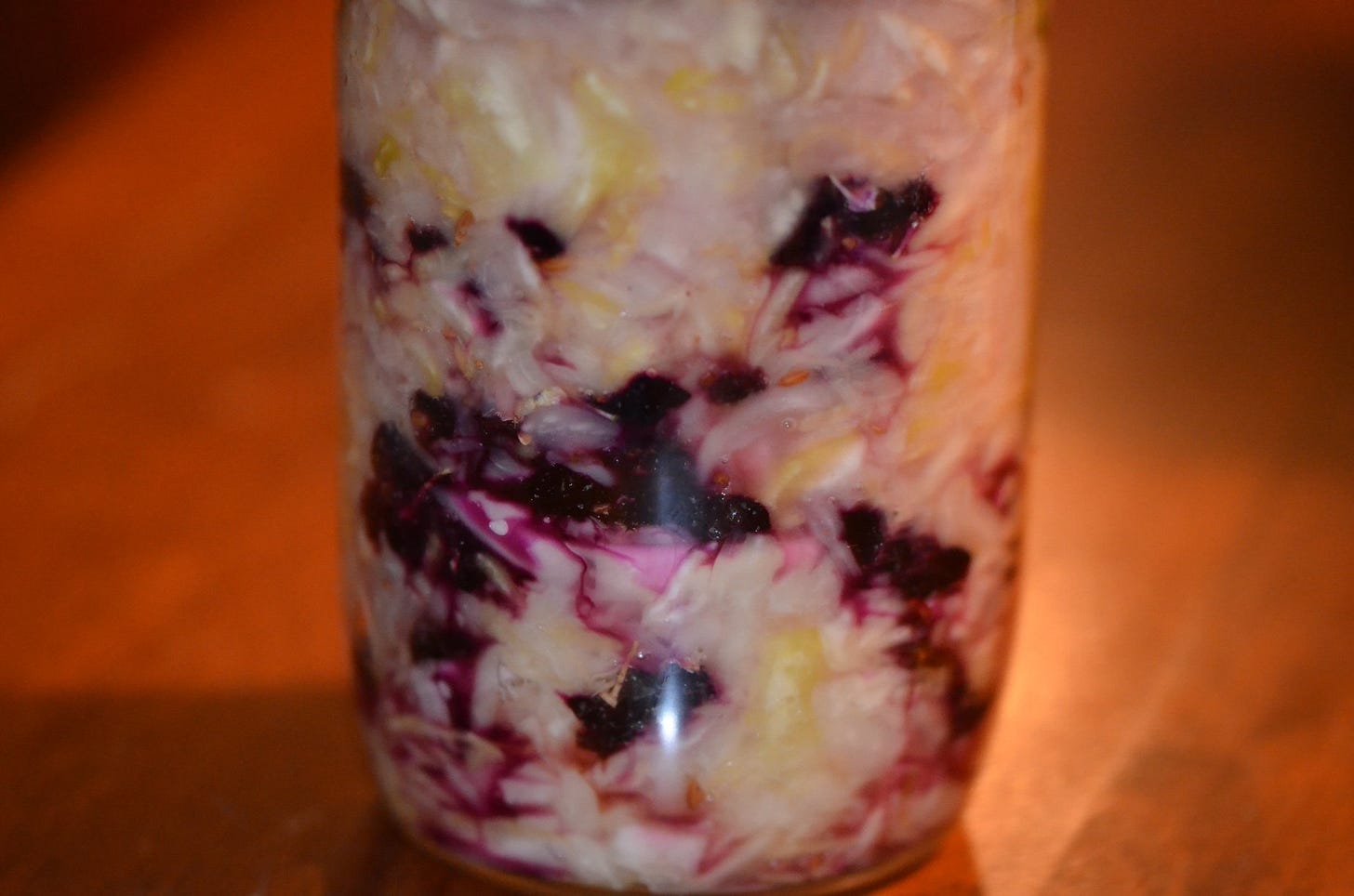


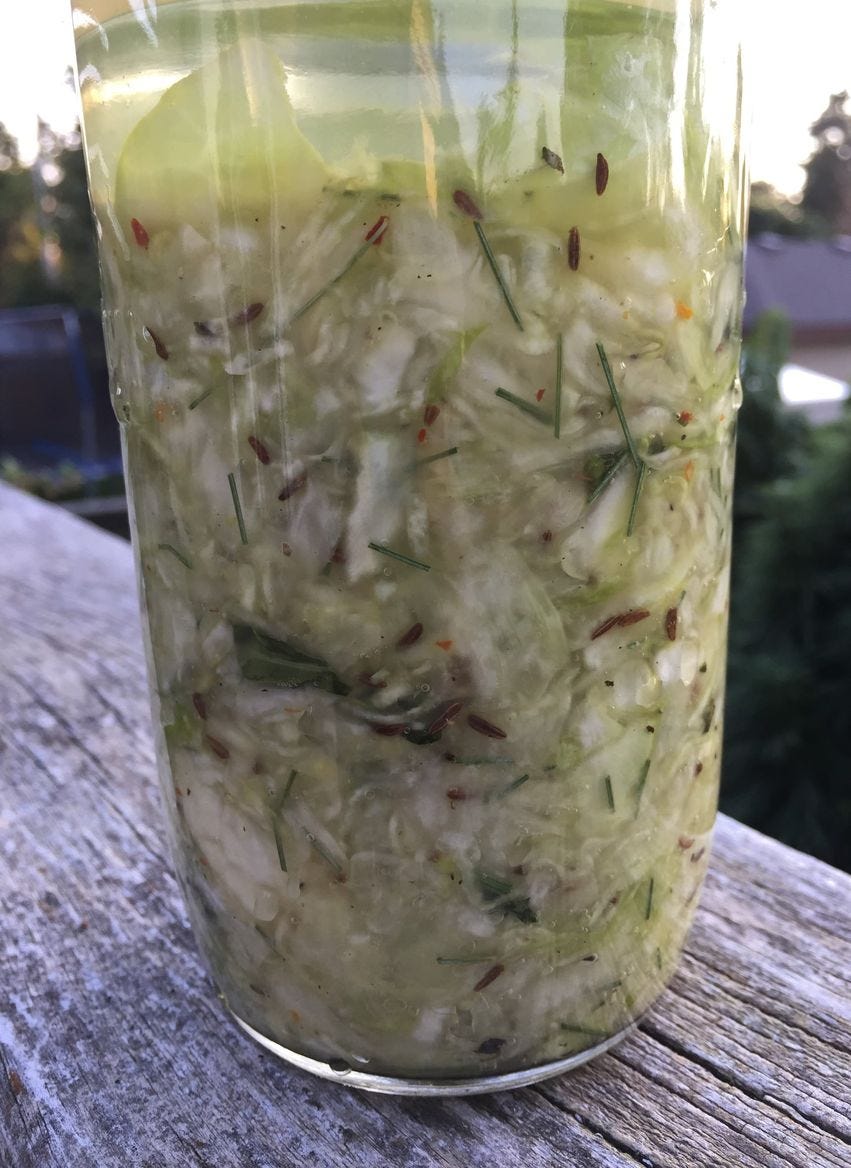
23. Sauerkraut helps you to detox heavy metals (mitigating the harms of things like the toxic stratospheric aerosol spraying programs on your health).
The ugly truth is that we are exposed to heavy metals through contaminated non-organic/processed foods, furniture, carpets, pots and pans, personal hygiene products, mattresses, paint residue and through the air we breath being laced with heavy metals via the prolific stratospheric aerosol injection (weather warfare) programs.
Fermented foods contain beneficial bacteria that help your body naturally eliminate toxins and even heavy metals. These bacteria actually pre-digest the food making them more bioavailable for the body to absorb both the beneficial bacteria and the active enzymes also act as detoxifiers for the intestines.
While some people need more detox support than others, the unfortunate reality is that no matter how hard you try, you can’t avoid toxins altogether.
So how exactly do you detox? It starts by limiting toxin exposure as much as possible (remember you can’t avoid toxins completely, but you can mitigate your exposure) and support your liver’s natural ability to detox. This allows the liver to restore itself and catch up with the detoxification workload.
Here are a few ways to start detoxing:
Switch to non-toxic personal hygiene and cleaning products
Support methylation
Support liver function
Switch to a clean, whole foods diet (and include foods that specifically help with chelation)
Chelators are chemical substances that bind to toxins to remove them via urine or bowel movements. Some great natural chelators include amino acids, selenium, garlic, cilantro, and chlorella algae. These natural chelators latch on to toxic molecules in your body and can even change them into less harmful substances.
Adequate amounts of minerals and vitamins C & E also protect your body from the damaging effects of heavy metals.
Besides natural chelators, vitamins and minerals, microflora (good bacteria in your gut) can be your key to helping your body naturally get rid of heavy metal toxicity. Microflora are good bacteria and yeast (also called probiotics), which help you digest food, absorb nutrients, cleanse your system, and boost immunity.
Thus, we can’t talk about detoxification without talking about your gut. Supporting a healthy microbiome balance with probiotic-rich foods like sauerkraut is going to help lower inflammation, support methylation pathways, and overall health of your detoxification system.
Sauerkraut is made from cabbage that contains both sulforaphane and glutathione that will continue to level up your methylation pathways. Thus Sauerkraut is a detoxifying wonder, especially when it comes to heavy metals.
With proper nutrition and healthy levels of beneficial bacteria, you can remove already accumulated heavy metals and avoid further toxicity.
24. Eating sauerkraut can help our pancreas better do its job.
Your pancreas produces a variety of essential digestive enzymes that break down starches, proteins, and fats. Unpasteurized sauerkraut is very high in viable enzymes that work just like the ones from the pancreas.
Fermented foods: sauerkraut, soy sauce, kefir, and other fermented foods are full of beneficial bacteria (probiotics) that improve your gut health and reduce pancreatitis symptoms; recent studies also show that ingesting probiotics regularly helps prevent pancreatic cancer.
25. Eating sauerkraut will add years to your life.
Research conducted at the University of Idaho performed a qualitative study involving in-depth interviews with centenarians from around the world to identify their dietary and lifestyle patterns responsible for their longevity. These centenarians are based in Italy, Japan, Singapore, Cuba, and the United States.
One of the common elements they identified is that these centenarians eat fermented foods daily, leading them believe there is an association between daily consumption of these foods and a long healthful life, as these centenarians have maintained healthy immune systems and gut function.
26. Eating Sauerkraut promotes better heart health
Sauerkraut contributes to a healthier heart.
That’s because it contains a good amount of fiber and probiotics, both of which help reduce cholesterol levels.
Probiotics such as those found in sauerkrau also help lower blood pressure slightly in people with hypertension.
Moreover, sauerkraut is one of the rare plant sources of menaquinone, more commonly known as vitamin K2.
Experts believe vitamin K2 reduce the risk of heart disease by preventing calcium deposits from accumulating in your arteries.
27. Eating sauerkraut with high-protein foods or foods rich in fat – yummy! – makes the foods easier to digest.
Probiotics also help make foods more digestible, which increases your gut's ability to absorb the vitamins and minerals they contain.
That means your daily forkful of sauerkraut also helps you to get more out of the other foods you eat during the day (this is especially true with regards to high-protein foods).
28. Sauerkraut helps with weight loss.
Obesity has become a worldwide epidemic, resulting in heart and digestive problems. Sauerkraut can make you feel full even without eating a lot of food, due to being high in fiber while also low in calories. Adding sauerkraut to your diet regularly can leave you feeling fuller longer, replacing some other empty calories you might be otherwise tempted to consume!
Additionally, certain types of probiotics have been found in studies to support weight loss.
29. Sauerkraut reduces risk of cancer
Cabbage, the main ingredient in sauerkraut, contains antioxidants and other beneficial plant compounds that helps reduce the risk of certain cancers.
The cabbage fermentation process also creates particular plant compounds that suppress the growth of precancerous cells.
The cabbage in sauerkraut contains a rich compound called sulforaphane that prevents oxidative damage in the body. It also prevents cell mutation and blocks the excessive growth of cells. This protects against cancer, especially colorectal cancer.
For example, a recent study of Polish immigrants in the United States found that consuming more cabbage and sauerkraut significantly reduced breast cancer risk.
The beneficial compounds in cabbage may also protect against:
colon cancer
liver cancer
prostate cancer
30. Being Able Preserve Seasonal Vegetable Abundances (such as cabbage) In A Nutrient Dense Form Using Low Tech Tools Increases Your Emergency Preparedness Skills
In the case of the crippling of major food supply lines and/or the collapse of major components of the technological infrastructure that supports our industrial food system (whether via a manmade or natural disaster) the systems that facilitate the production and distribution of popular shelf stable foods (such as canned food) will not be available.
Learning to transform seasonal abundances (whether they are from the farm field, the garden or the forest) into delicious probiotic rich preserves through learning about lacto-fermentation (by making your own sauerkraut) means you will be able to use nothing more than salt, your hands and widely available containers to preserve what is available to you in the form of veggies and herbs so that you have access to nutrient dense food for months ahead in an off grid and/or emergency situation.
I hope this will inspire you to try creating some of your own sauerkraut. Each step we take to boycott Big Pharma as well as Big AG and instead embrace Mother Earth's medicine cabinet is a conscious choice to move into health sovereignty and realign our creative energy with the regenerative capacity of the living planet.
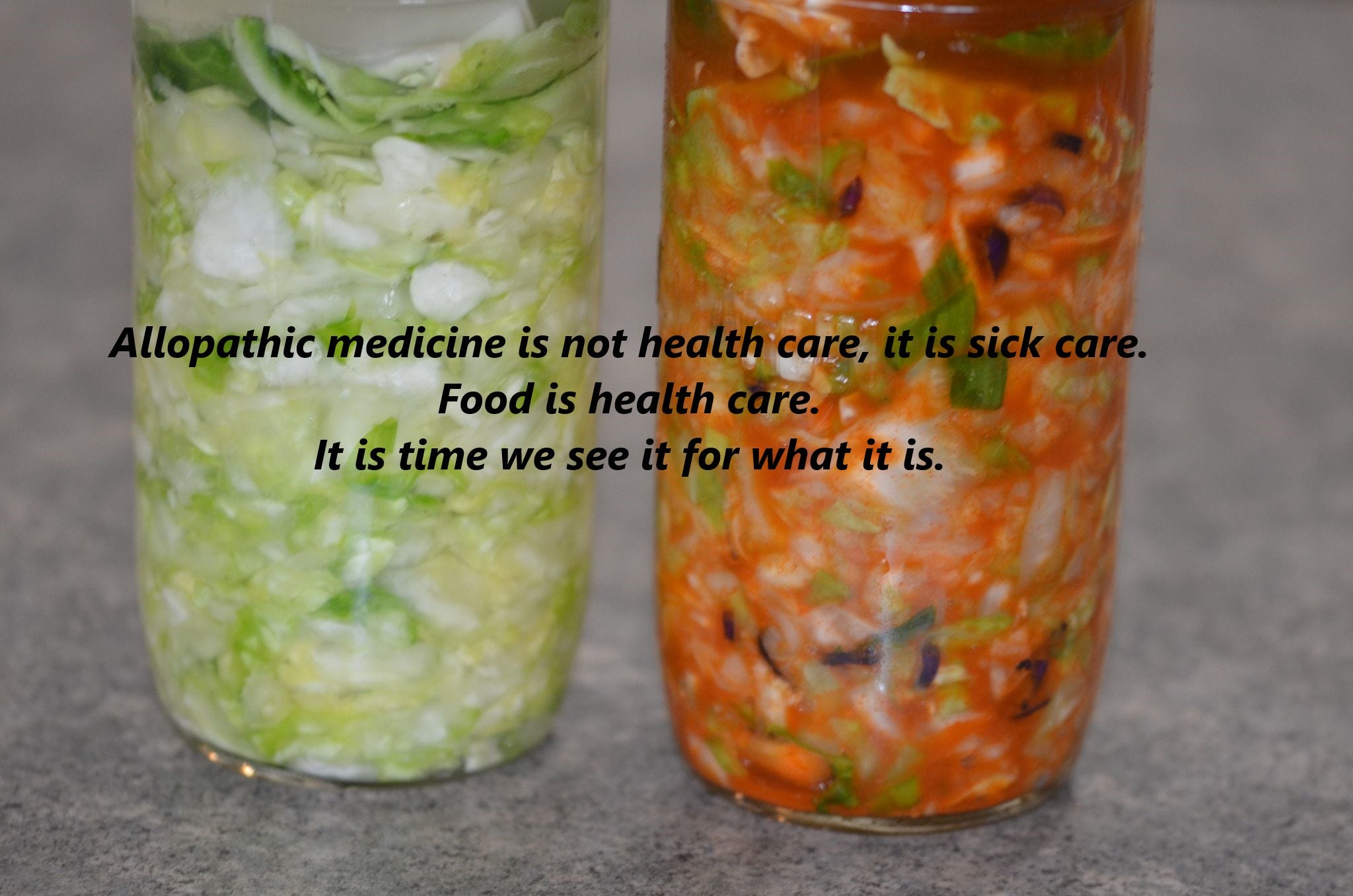
Fermented foods (such as sauerkraut) are by no means a ‘cure all’ but (as I described above) these are foods that can help to lay the foundation for a generally more resilient body, increasing one’s longevity and optimal function of the innate immune system.
The recipe for Sauerkraut above is from my recently published book (cover shown in image below).

For those interested in purchasing a physical copy of the book you can do so through this link:
https://recipesforreciprocity.com/shop/softcover/





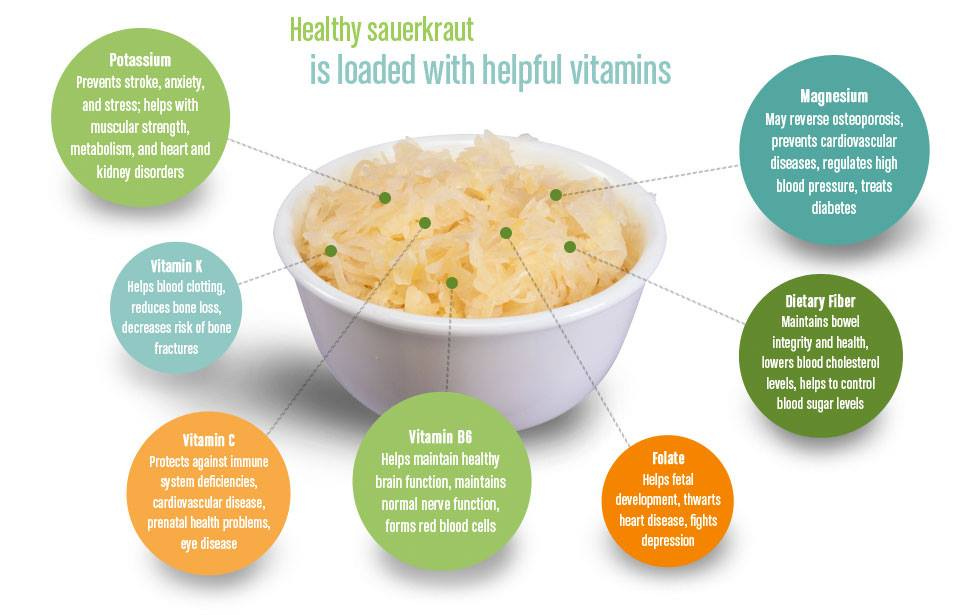



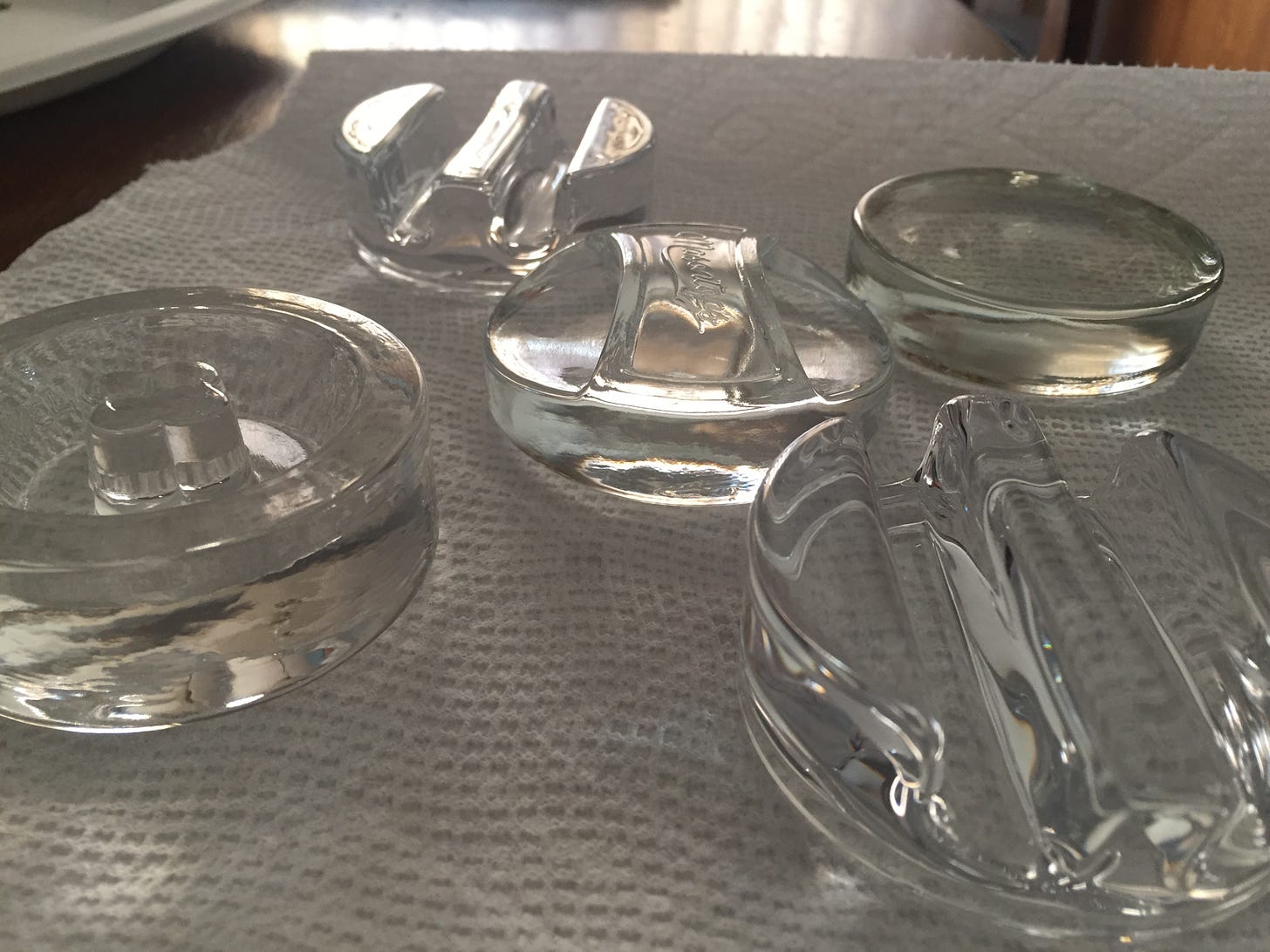
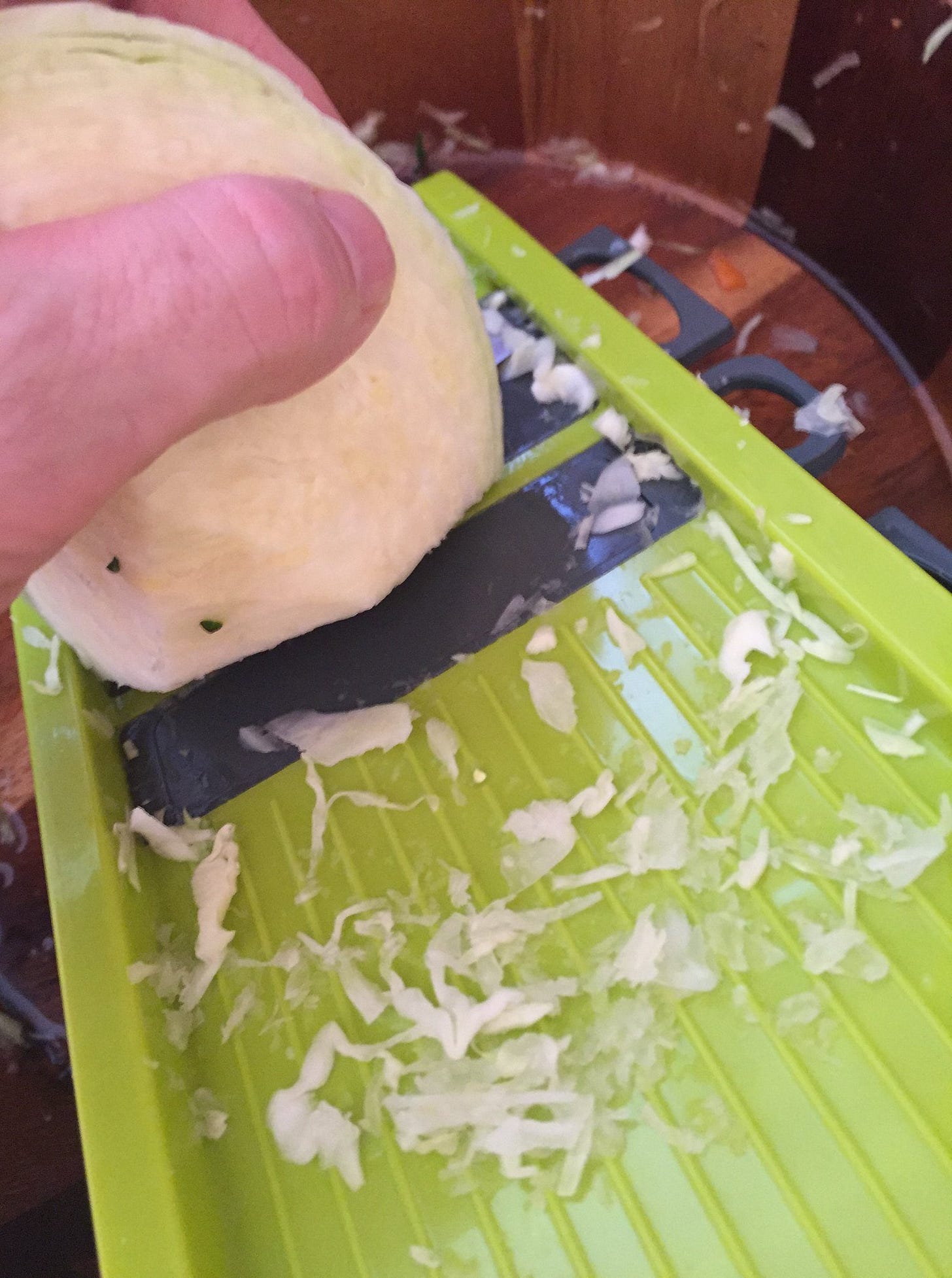
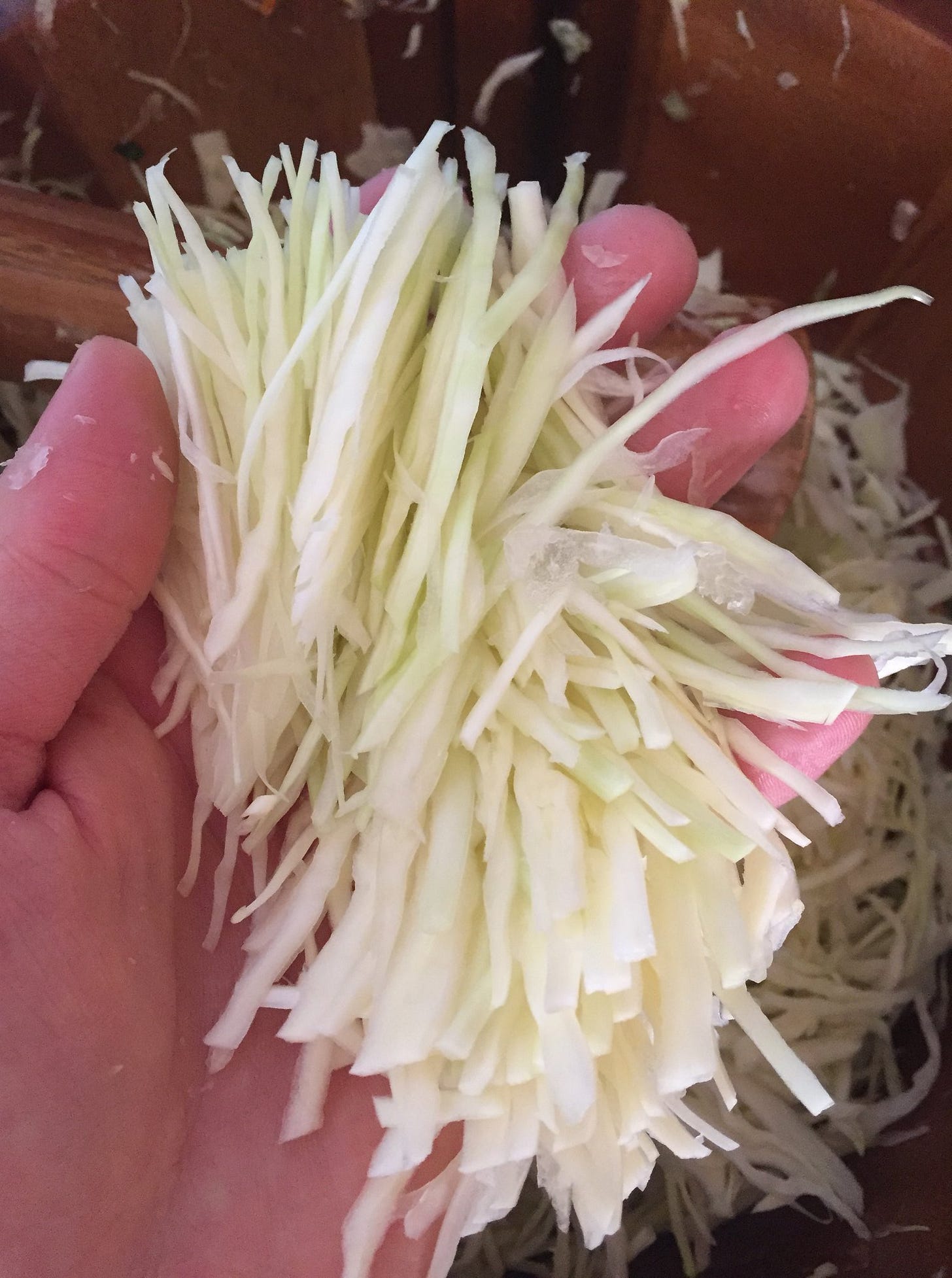
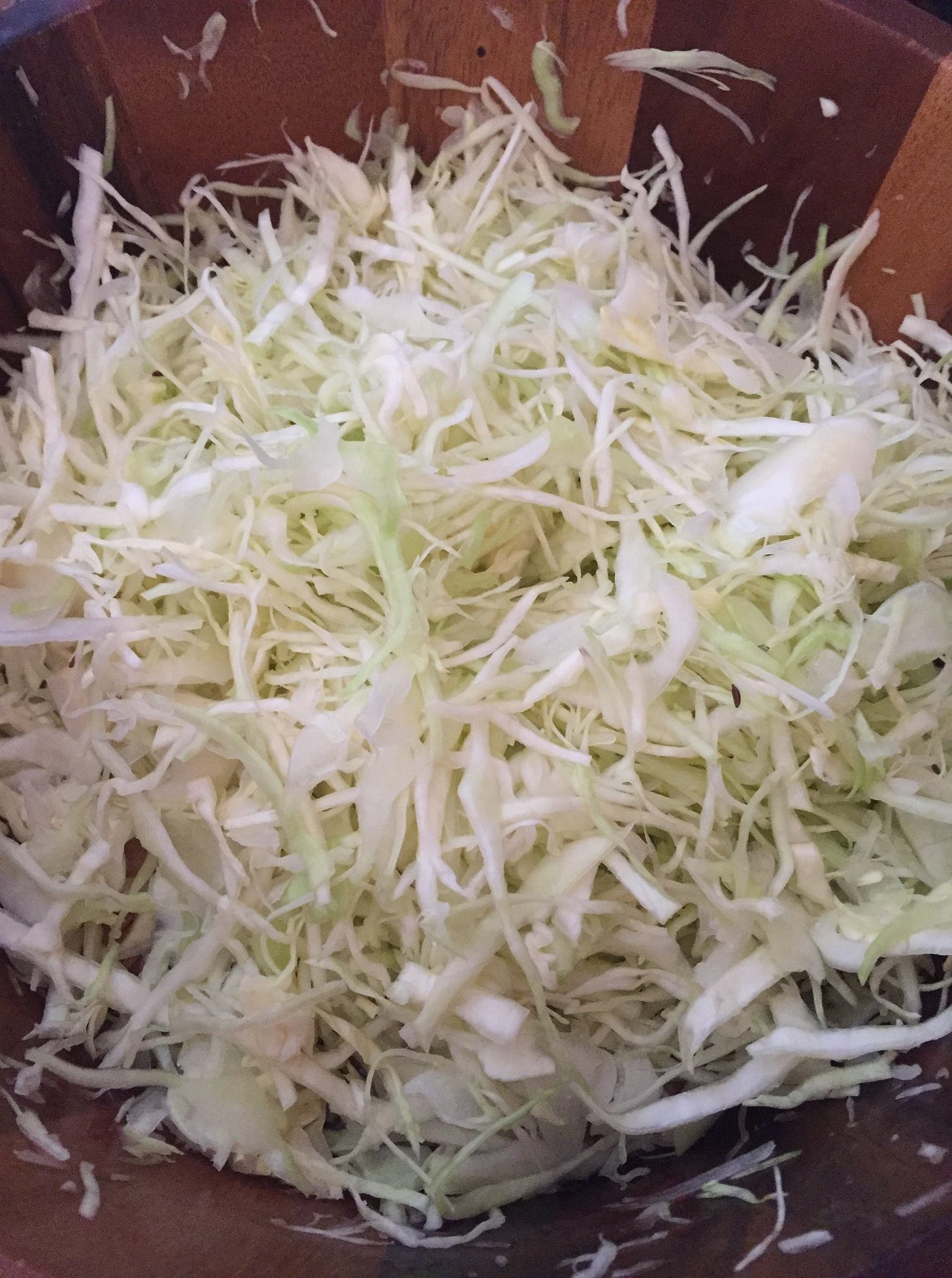

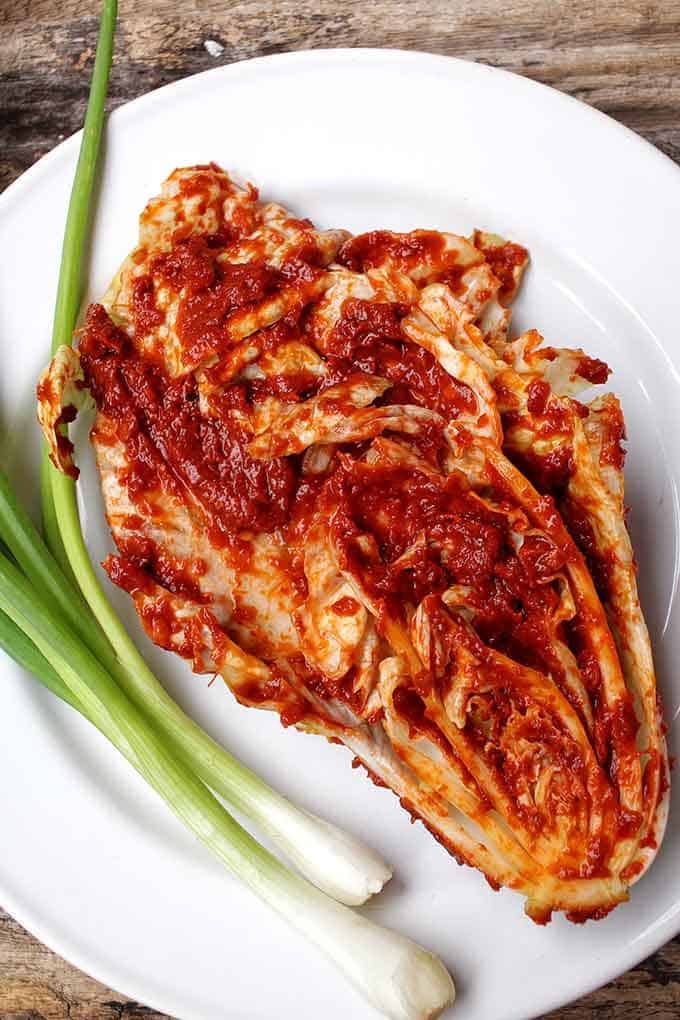

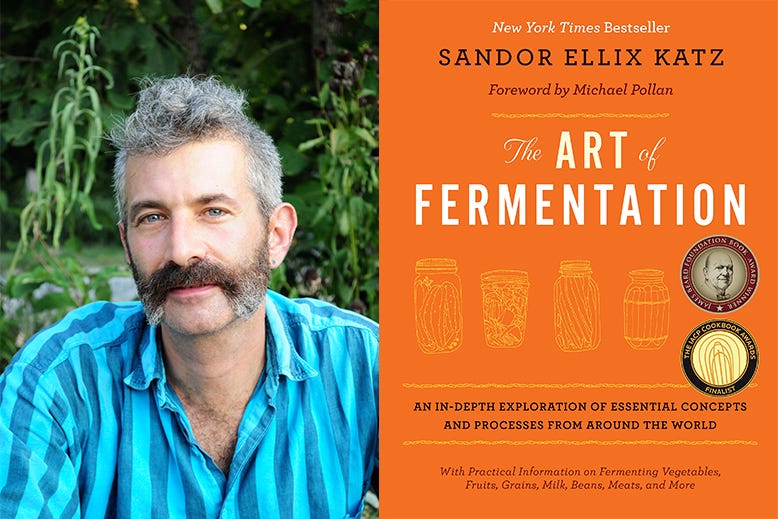

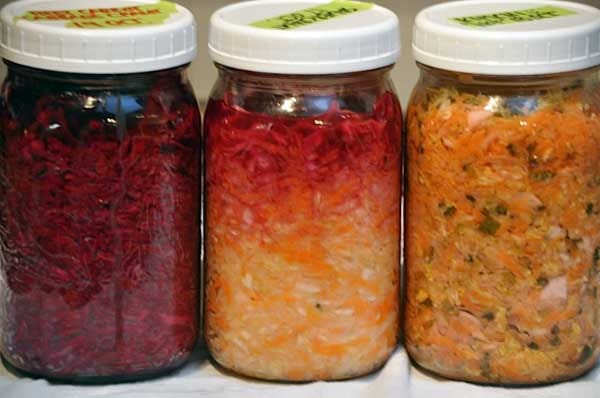

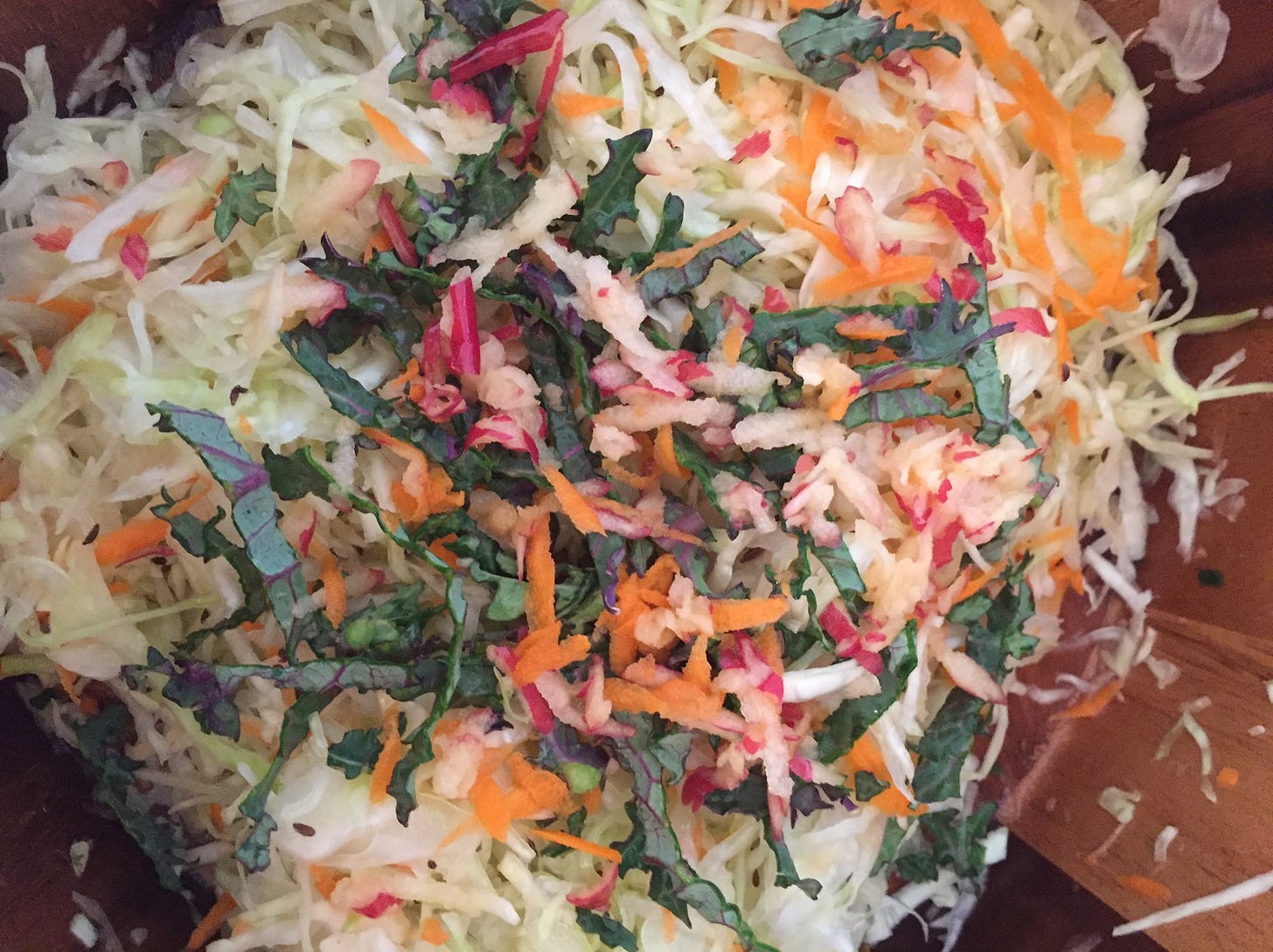
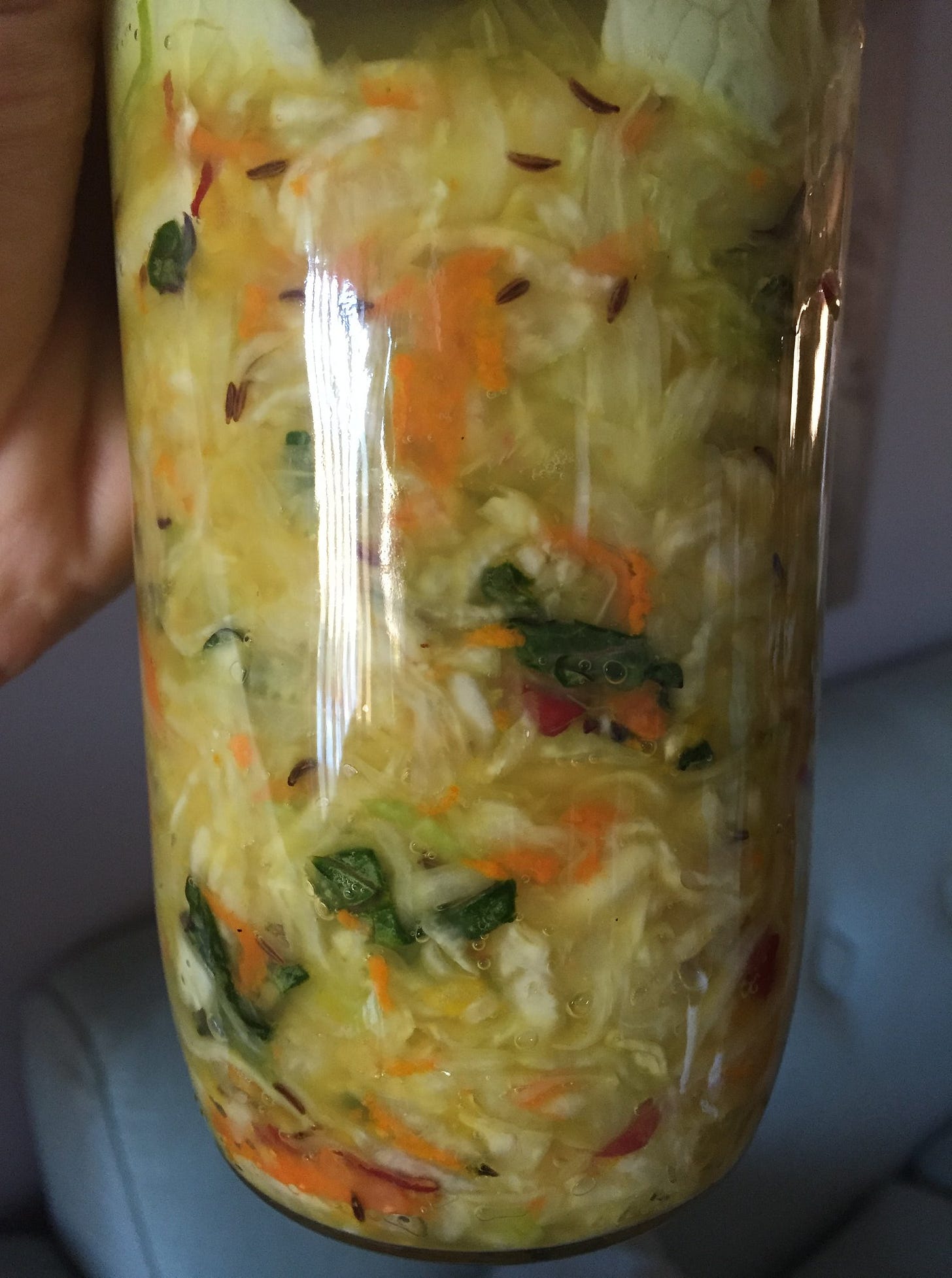
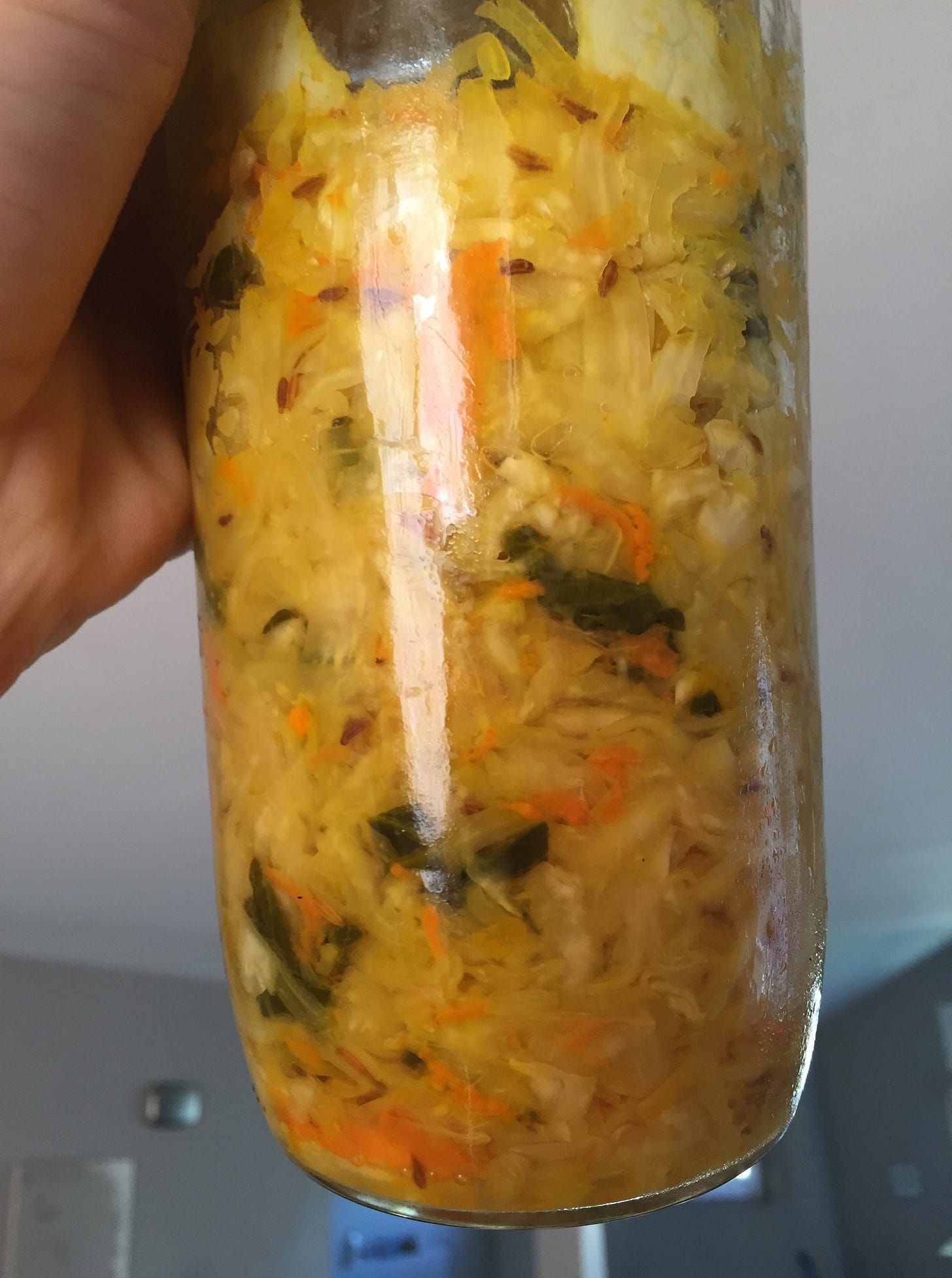
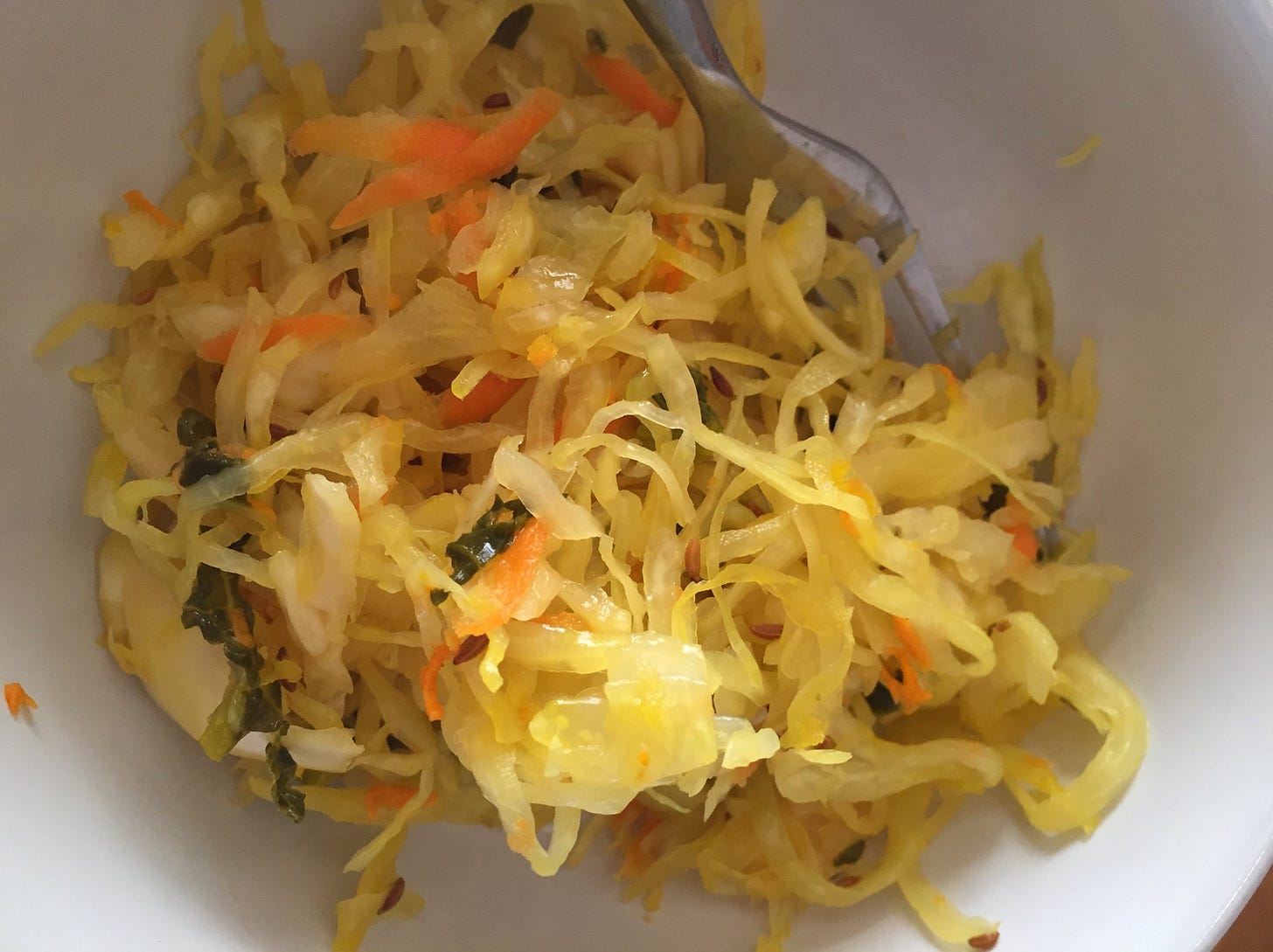
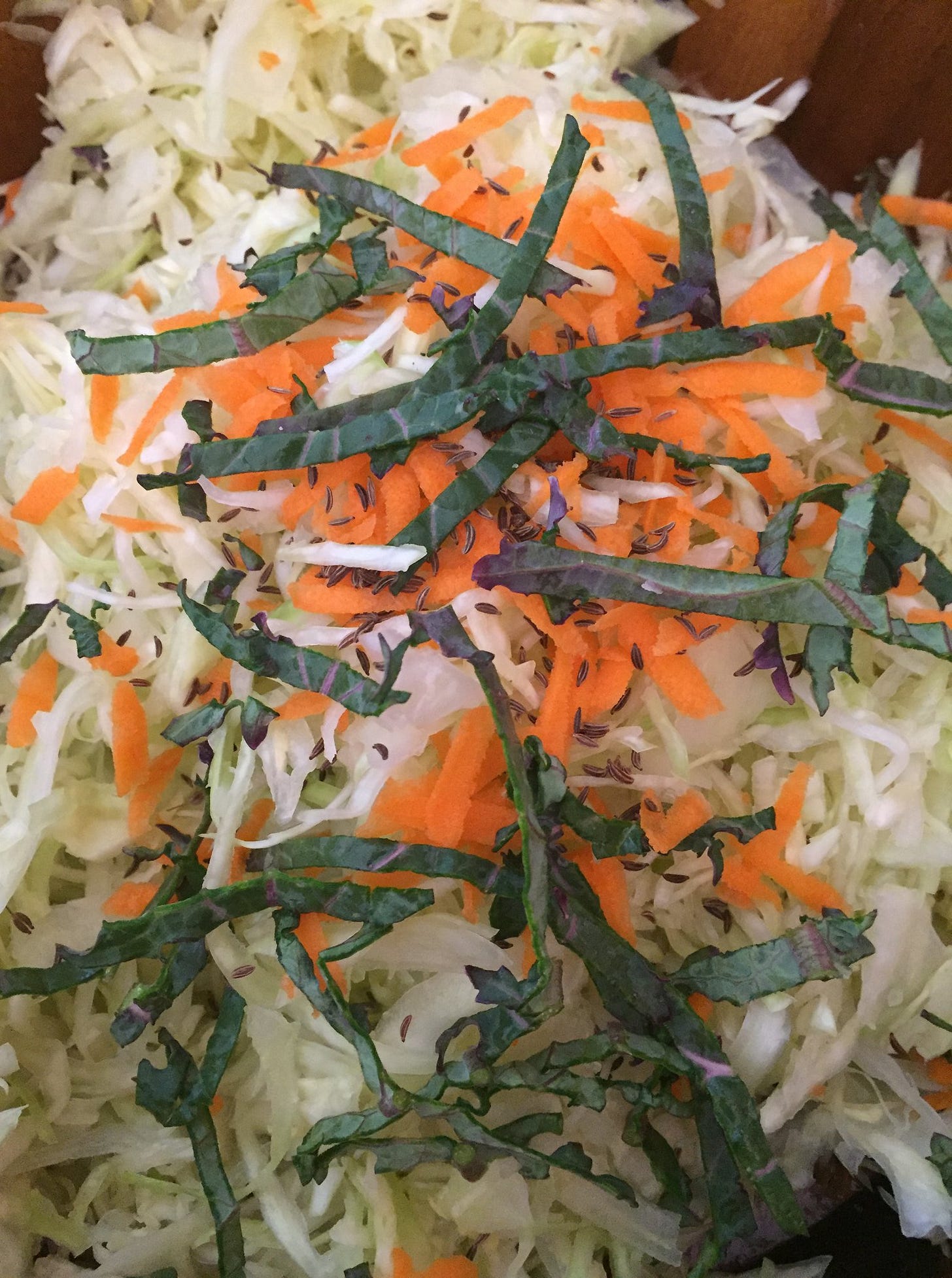
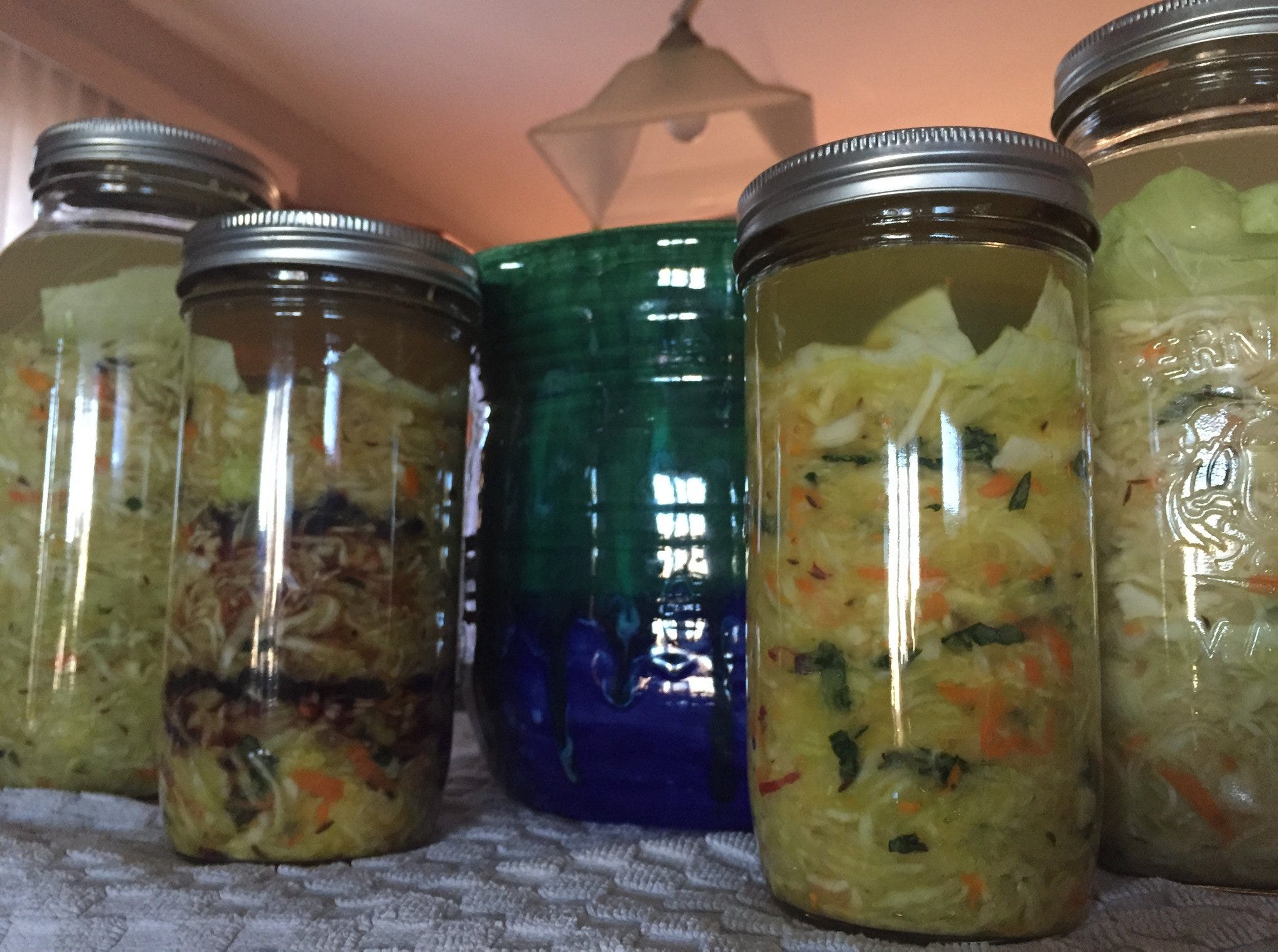
Take ten to 15 cabbages. Slice all. Place a layer in a new, washed garbage can. Sprinkle several tablespoons of salt on top. Repeat until you have 18” of space on top left. Fill 1/3 black garbage bag with water and tie. Place on top to seal. Check edges are sealed. Leave in the garage for two months or more in the fall. (The product is not sour or salty. It is mild tasting). Scoop 4 or more cups to have with baked ham and potatoes or pork. Have with hot Italian sausages. And scalloped potatoes. Many more. I made sourkraut every fall for decades. Once done, half can also be canned for the next year. Really easy. Great nutrients and a staple vegetable source. Obviously I also canned fruits and jams. I don’t understand why young people do all of the work for such tiny quantities today when they can do all in august - September and have a huge larder for the winter. Be free from supply chains and grocery stores. Consider a garden. Cheers all! Ps, get that info from us old grannies before this knowledge is gone.
Love reason #10: Since sulfur helps us structure our body's water, it would make sense that sauerkraut is a form of EMF insulation for us: https://romanshapoval.substack.com/i/120334740/how-i-structure-my-water